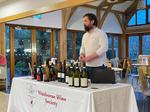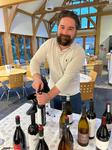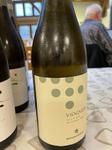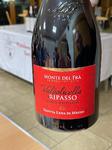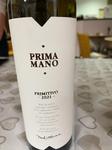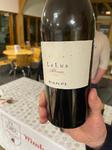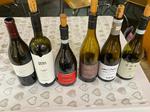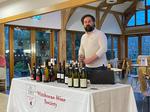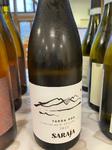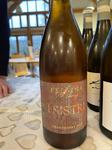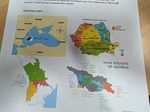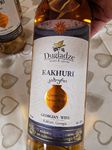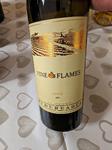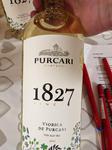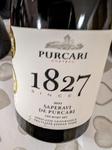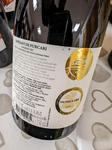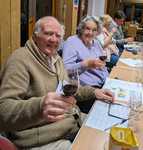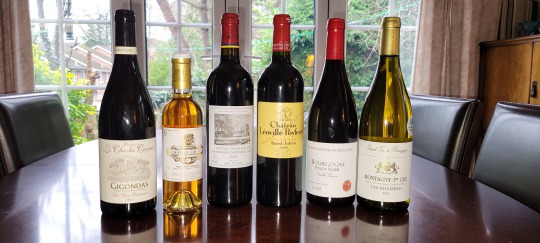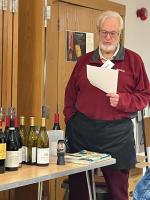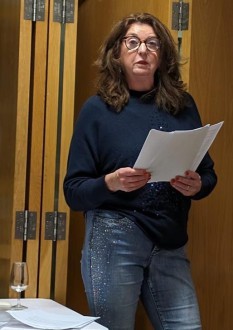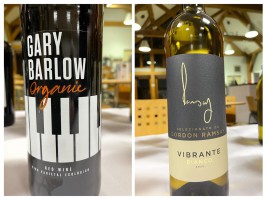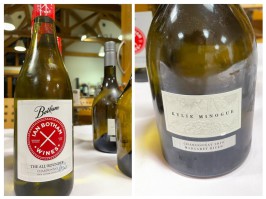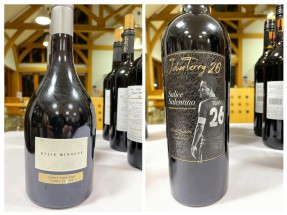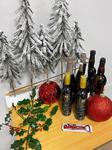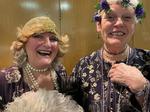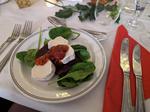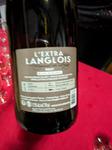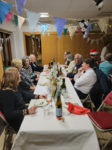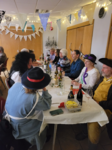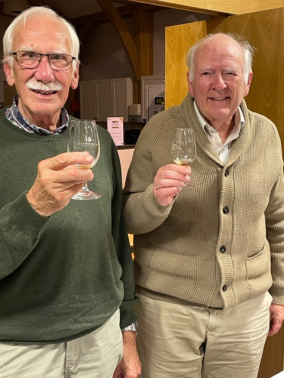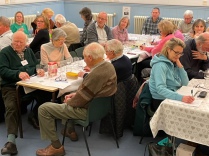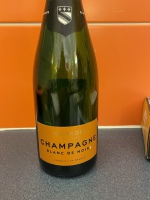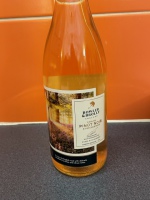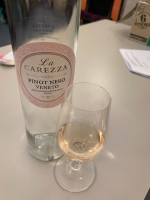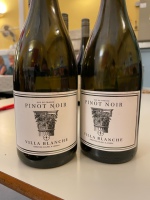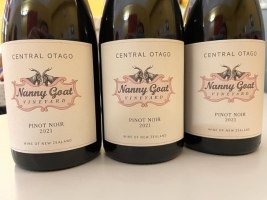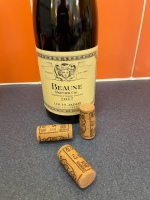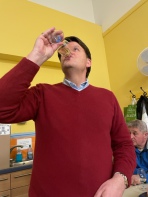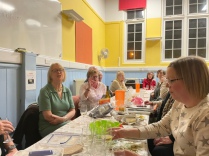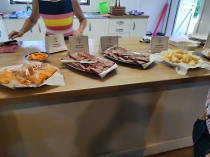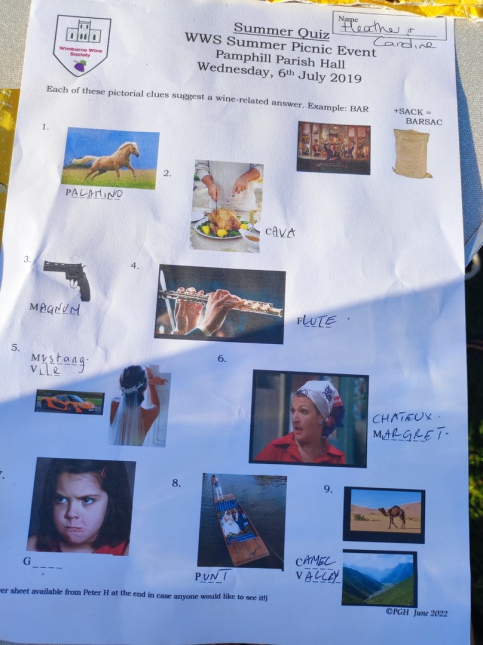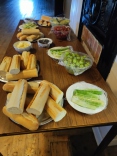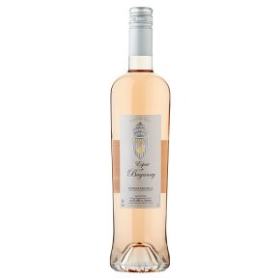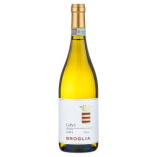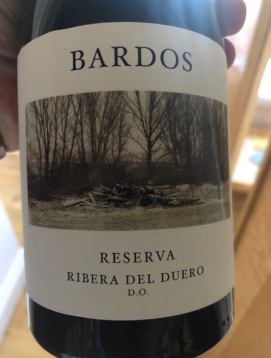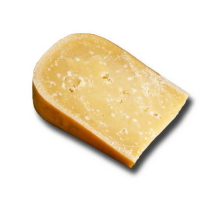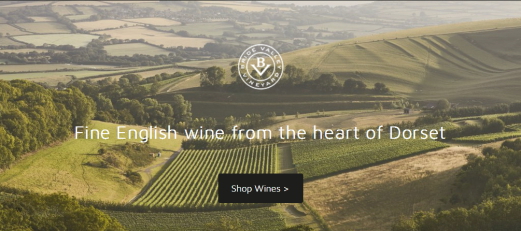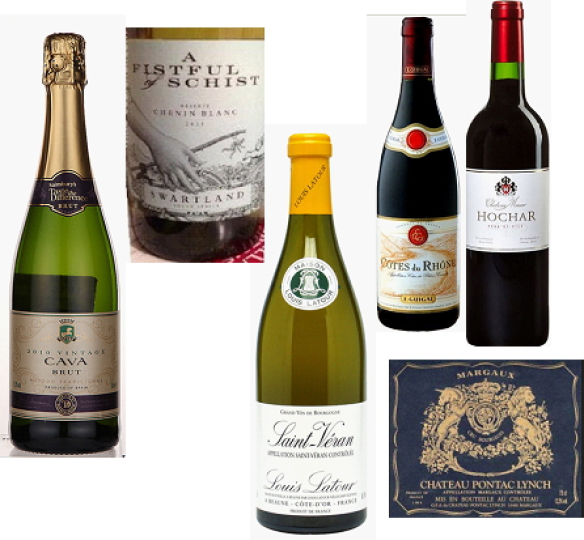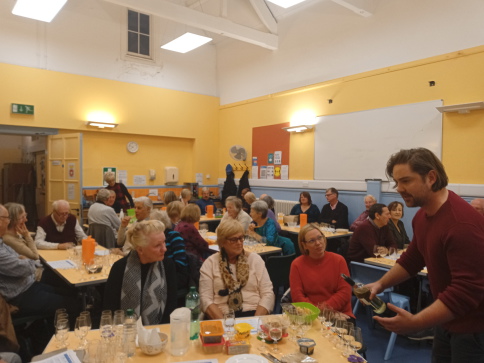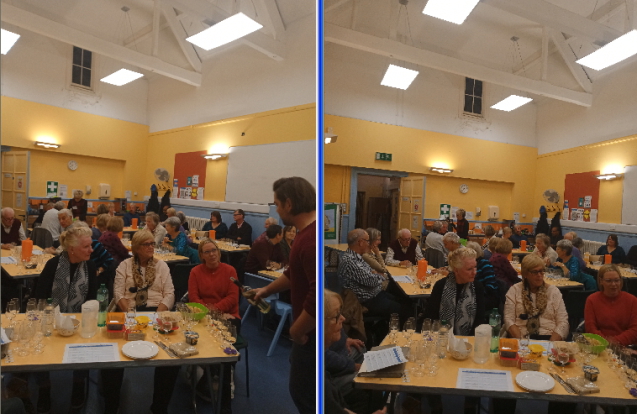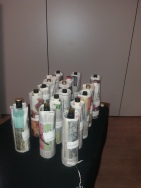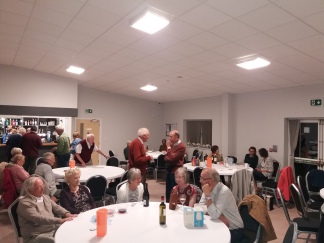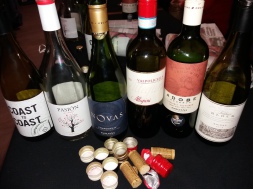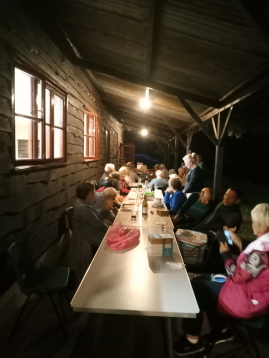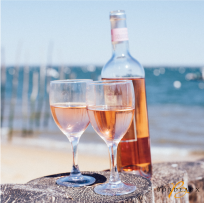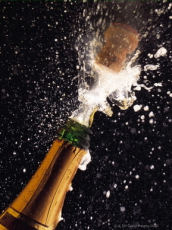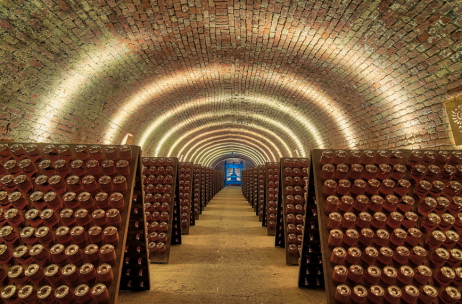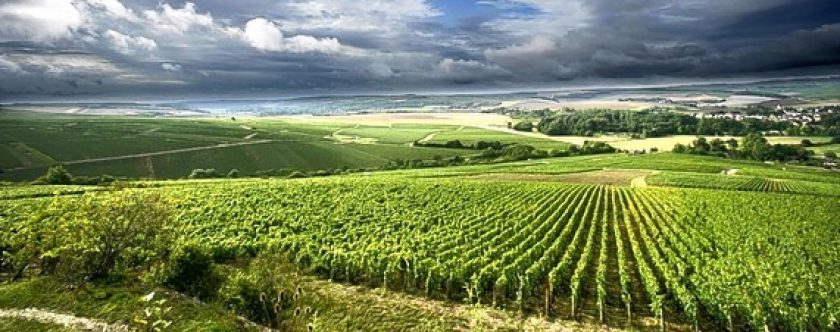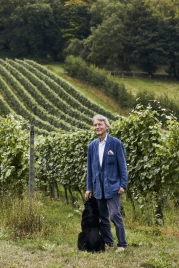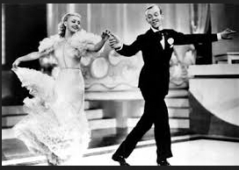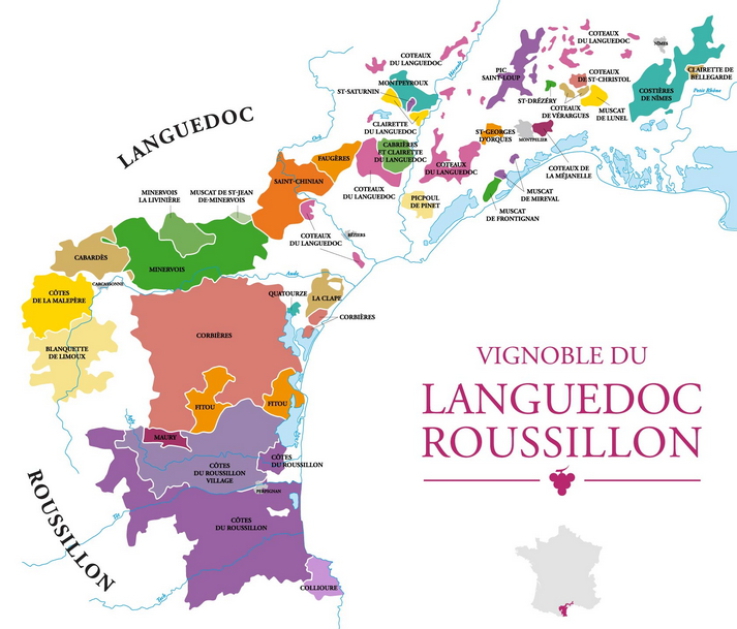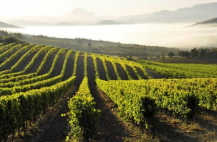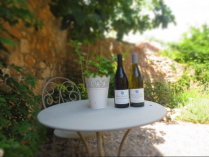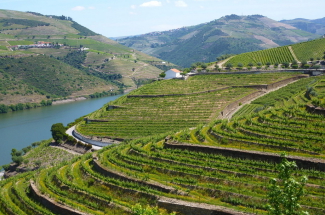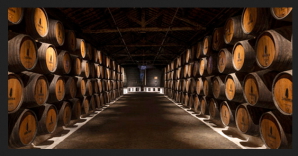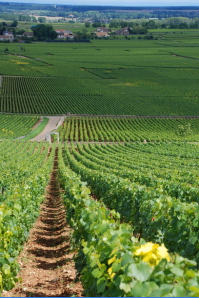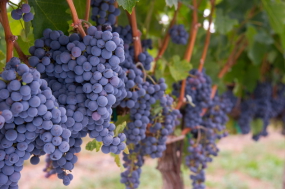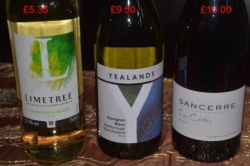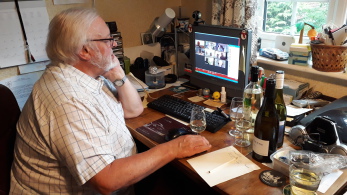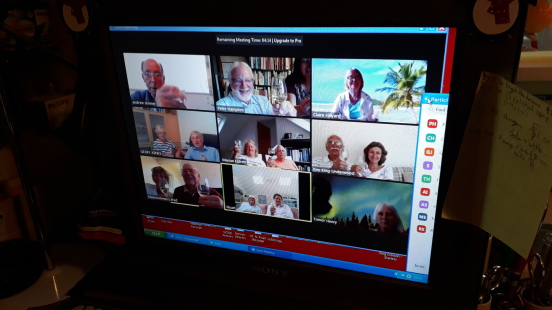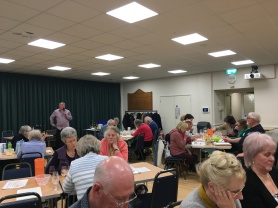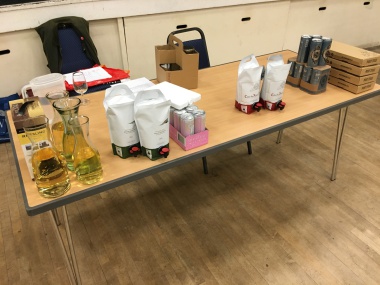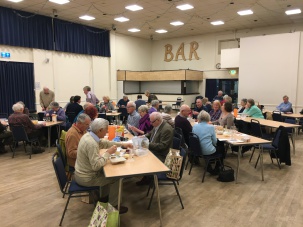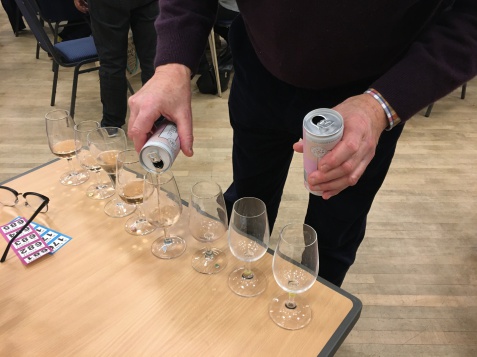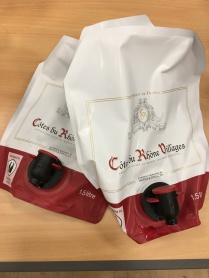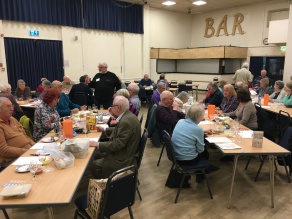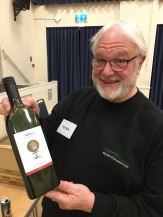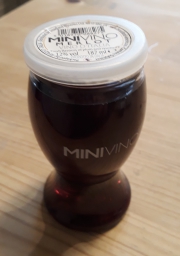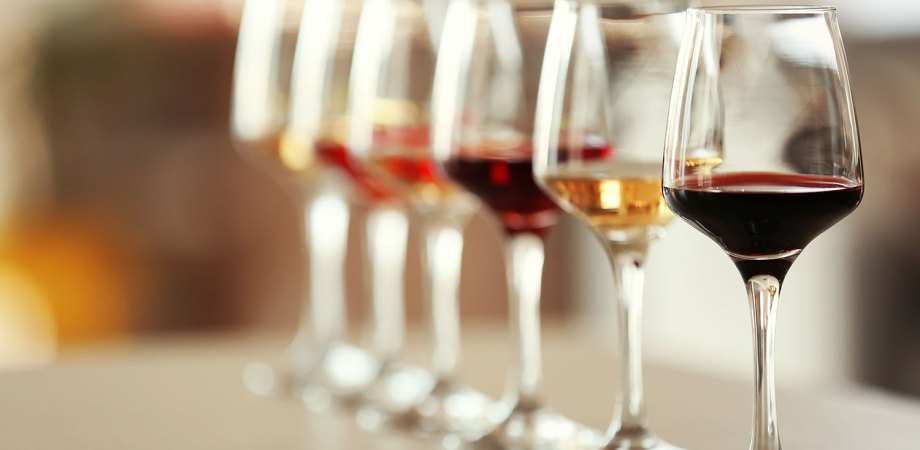
Wednesday 3rd July 2024
Summer Party in the
M.E.D. garden
42 members and guests attended our summer picnic where we enjoyed a lovely selection of savoury flans and salads provided by Rachel at Deli Hart; accompanied by wine we had brought ourselves.
The rain (mostly) held off so we could enjoy a treasure hunt quiz in the garden provided by Barbara and a game of 'Toss the cork as close to the bottle as you can!' provided by Stuart & Sue; and won by Amanda.
Wednesday 5th June 2024
"Beautiful Burgundy"
Presented by Claire Hillyard & Caroline McGregor,
WWS Committee Members
Wednesday 1st May 2024
South African Wines
Presented by Preet Sahota,
Edgmond Wines, Newport, Shropshire
A well-attended meeting (37). Preet gave a very interesting presentation, covering how he began in the wine industry and set up his business. He is very enthusiastic and knowledgeable about the wines he sells, and has visited all the wineries from which his wines are sourced, and anecdotes about his trips to S,Africa gave us an insight into some of the producers. (See "wines tasted" pages for information on the wines and vineyards concerned.)
He was also able to offer us significant discounts on any wine we wished to purchase.
Wednesday 3rd April 2024
Italian wines
Presented by Daniel Read,
New Forest Wines, Ringwood
Name of presentation: Wines of Italy
Month of presentation: April 2024
Presenter: Daniel Read (New Forest Wines)
Q Why did you choose this theme?
A Since WWS hadn't received a presentation on Italy for a while, it was an easy decision to make. Our Italian selection at New Forest Wines is particularly strong, so it was a great opportunity to showcase a lovely selection.
Q What was your favourite wine of the six tasted?
A All the wines have their individual qualities, but my preferred choice would be the Banfi 'La Lus' Albarossa. I would like to put out a special mention to the Saraja 'Tarra Noa' Vermentino though, a superb wine for well under £20.
Q What was WWS members reactions to the wines tasted?
A The general consensus seemed to be positive, it's good to know that we're doing something right!
Any Links to related articles/further information:
Website: https://newforestwines.com/
Instagram: https://www.instagram.com/new_forest_wines/
Facebook: https://www.facebook.com/newforestwines/
Q Overall favourite white wine of the
evening?
A Felsina Berardanga ‘I Sistri’ Chardonnay 2020
Overall favourite red wine of the
evening?
A Banfi ‘La Lus Albarossa 2019
Wednesday 6th March 2024
Wines from Eastern Europe
Presented on behalf of Chris Holding by John Billington
WWS chairman
Wednesday 7th February 2024
Peter's Cellar
Presented by Peter Hampton
WWS committee member
An imaginary tour of Peter's cellar, presenting a selection of wines collected over several years.
Subjects covered:
- Creating a cellar (doesn't have to be underground - any cool quiet vibration-free room or area will do. Avoid temperature fluctuations and excessive dryness.
- Decide what wines you like and research them, using reputable wine merchants, either online or physically present
- How to purchase "en primeur": assuming you have chosen wine(s) which can be long-lasting,
- Refer to independent sources (e.g Decanter magazine) to select good quality wines which will benefit from ageing. Many wine merchants will store wines for you "in bond" - at a price - when they receive them from the producer. Pay duty & VAT when you want to take delivery yourself.
- Keep a "cellar book" to record when wine was purchased, price, vendor, leaving space for tasting notes, the date consumed and what the occasion was.
Wednesday 3rd January 2024
Celebrity Wines
Presented by Tracie Billington-Beardsley
WWS committee member
Q Why did you choose this theme?
A Who doesn’t love a bit of celeb gossip? Wines endorsed and produced by celebrities have seen a huge increase with filmstars, footballers, rock stars, chefs and comedians launching their
own labels. But do these celebrity wines shine like the stars that produced them or will they only have fifteen minutes of fame?
Q What was your favourite wine of the six tasted?
A I was pleasantly surprised by the organic red by Gary Barlow of Take That fame. At only £8 a bottle it is incredibly good value for an organic wine. A drinkable, everyday wine.
Q What was WWS members reactions to the wines tasted?
A Celebrity Proseccos had got a bad press so there was a feeling that the wines may be likewise.
In the Chardonnay compare and contrast which saw Kylie Minogue go head-to-head with Sir Ian Botham – the cricketer’s All Rounder Chardonnay hit a six with a majority of members. None knew the price
before tasting but the less expensive at £11 compared to £20 was the player of the match!
Member Amanda, not normally a red wine drinker, found a red wine she enjoyed in John Terry’s full-bodied Wine of Champions Salice Salentino 2020.
Long-time members Mike and June, experienced wine tasters, shared their scoring system with the meeting and revealed that some of the celebrity wines (Kylie Minogue’s Pinot Noir 2020 and Ian Botham’s
All Rounder Chardonnay 2023) hit a five with seven being the highest score.
Member Stuart won the most celebrity puns worked into sentences during the evening.
Links to related articles/further information:
Best celebrity wines: How good are they? - Decanter
Q Overall favourite white wine of the evening?
A Ian Botham All Rounder Chardonnay
Overall favourite red wine of the evening?
A John Terry Wine of Champions Salice Salentino 2020
~~~~~~~~~~~~~~~~~~~~~~~~~~~~~
~~~~~~~~~~~~~~~~~~~~~~~~~~~~
Wednesday 6th December 2023
Our Christmas meal
at the Museum of East Dorset
A very pleasant evening enjoying canapes and a welcome drink; followed by a four course meal with an interesting variety of wines at each table, brought in by members.
Some members took part in the optional fancy dress competition!
Click here for our hearty rendition of Good King Wenceslas! (as seen on Facebook)
~~~~~~~~~~~~~~~~~~~~~~~~~~~~~~
Wednesday 1st November 2023
AGM
chaired by John Billington
then
"Fortified Wines"
Presented by:Roy King-Underwood and Mike Webber (WWS members)
AGM: John briefly covered WWS events of the year, and also a treasurer's report summary - our financial state is healthy. We are closing our HSBC account and moving to Santander, who have been more accommodating with regard to our requirements.
The fortified wines presentation then followed...
Mike first gave an overview of the general principle of how fortified wines are made and stored. Mike and Roy then alternated in telling us about the following wines:
1. "Porto Branco" - Graham's Fine White port, nv. 19%abv,Wine Society, £13.95/btl.
A blend of several Portuguese grapes, resulting in a pale-lemon coloured port, just slightly off-dry, notes of apple skin, honey and almond. Good length. Served chilled, this is a lovely aperitif, and wsould mix beautifully with tonic for a longer drink.
~~~~~~~
2. Alegria Manzanilla, sherry.
Palomino grape.Pale lemon colour, dry slightly 'dusty' nose. Apple hints and slightly 'salty' (its origin and storage at Sanlucar de Barrameda, by the sea at Jerez, may have somthing to do with this). Lovely dry finish. have it with olives!
~~~~~~~
3. Gonzalez Byass Tio Pepe Fino sherry. 15%abv, Tesco, £13
Palomino. Pale gold, nutty dry nose. Taste v.dry and lightly yeasty, Hazelnut skins.
~~~~~~~
4. Pellegrino Cantine de Vita Marsala, Sicily, 18%abv.Waitrose £12.49
Grillo & Cataratto grapes. Deep gold, medium walnutty finish. Matured using Solera system.
~~~~~~~
5.Blandy's Verdelho Madeira 10 y.o. 19%abv, Wine Society £21.50/50cl btl
Verdelho grape. 1 step sweeter than Sercial, the dryest. 1 drier than Bual. Brownish gold, pale aureole. Medium sweetness. Nutty, dryish slightly honeyed nose. Dried fruit finish, hints of coffee.
~~~~~~~
6.Stanton & Killeen Rutherglen (Victoria) Muscat, 12 y.o. 18%abv,Wine Society, £19/half btl.
Muscat grape. Dark brown; Oaked, molasses nose, toffee and dried fruit - 'liquid Christmas cake' taste. massive length.
Try with chocolate?
~~~~~~~
Over all, a very successful tasting, covering a wide varity of fortified wines - note, only one port tonight. We'll try and get a port tasting together for Autumn next year.
Wednesday 4th October 2023
"Call My Bluff"
Presented by Claire Hillyard, WWS Committee
In this format of meeting, members blind-taste a number of wines, and form their own opinions of it. They then listen to different descriptions of the wine, and vote for the description that they think is right - or most closely matches their own feelings.
To start with:
Wine no. zero.
Chateau d'Esclans "Whispering Angel" Rosé. 13%abv, approx £20
The Chateaux D'Esclans Whispering Angel rosé wine has become the headline act for Provence rosé in recent years.
But, what makes it stand out and does it offer good value for money?
This iconic wine has a wealth of awards behind it and has revolutionised rosé wine.
A little about the history and naming.
The Chateaux D’Esclans is a vineyard north of Saint-Tropez and Frejus on the Mediterranean coast, and has been around since the mid 19th century, mostly known for Grenache grapes. In 2006 it was bought by Frenchman, Sacha Alexis Lichine and he is the man behind this great wine. Born in Bordeaux, with experience of every aspect of the wine industry, his vision was to create the greatest rosé in the world.
So why call the wine Whispering Angel?
A lovely name fitting the delicate flavours and pale pink colour - the name is drawn from the cherubic angels in the chapel at the chateau. As Sacha Alexis Lichine is quoted as saying “In the Esclans Valley angels whisper. If you drink this wine, you might hear them. If by chance you visit us, you might see them.” The taste is full and lush while being bone dry. It has fresh notes of apple, pink grapefruit, peach and also strawberries with cream, with a long, smooth finish. Perfect with smoked salmon also shellfish, chicken and Goats cheese.
Grapes:
Grenache giving it the red fruit flavours of strawberry and raspberry.
Cinsault adding floral notes.
Vermentino (Rolle) the white grapes adding complexity.
Other wines tasted this evening were:
Wine1 Sancerre Domaine Naudet 2022 - 12.5% £20.99
Wine 2 Saint Veran - Marc Sudet 2021 - 13%. £22.99
Wine 3 Crozes Hermitage 2020 - 13% £16.49
Wine 4 St Emilion Chateau Laroque 2014 14% £30.99
Wine 5 Barolo Vendemia 2018. 14% £19.99
Wednesday 2nd August 2023
Spanish Wine
Presented by Stuart Warnock, WWS President
Spanish wine (Spanish: vinos españoles) Includes red, white,and sparkling wines produced throughout the country. Located on the Iberian Peninsula, Spain has over 1.2 million hectares (2.9 million acres) planted in wine grapes, making it the most widely planted wine-producing nation, but the second largest producer of wine in the world, behind Italy and ahead of France and the United States.
The country has an abundance of native grape varieties, with over 400 varieties planted throughout Spain, though 88 percent of the country's wine production is from only 20 grapes.
Major Spanish wine regions include:
The Rioja and Ribera del Duero, which are known for their Tempranillo production; Jumilla, known for its Monastrell production; Jerez de la Frontera, the home of the fortified wine Sherry;
Rías Baixas in the northwest region of Galicia that is known for its white wines made from Albariño and Catalonia which includes the Cava and still wine-producing regions of the Penedès
The Wines
Cava Mestres Coquet
Brut Nature
Cava Gran Reserva 2018
Brut Nature - is the driest Cava you can get with only 3g of sugar per litre. Where as a standard Brut is 12g of sugar per litre.
A Cava Gran Reserva is the highest grade of Cava you can buy. The wine must spend a minimum of 30 months on the lees for this classification.
This Gran Reserva, is made from local grapes Maccabeo and a small amount of Parellada.
It is aged on its yeast lees for an incredible 42 months.
The result is a delicate, textured and refined fizz with finesse and purity.
Alcohol Level 12% Style 1 - Bone dry.
Vintage 2018 Price £ 22.00 / Bottle
Muga Rosado, Rioja 2022
A stylish, vibrant Rioja Rosé or Rosada
from one of this famous Spanish region's leading lights. No oak here at all, just delicate, pretty and mouthwatering fruit.
Sue and I used to drink loads of this wine in Spain, it is easy drinking, and ideal for summer evenings. With or without food.
Muga, is one of the most traditional, of Rioja’s bodegas, with not a stainless steel tank in sight.
This particular wine is produced by a 12-hour maceration process and then fermented in 2,000-litre oak tanks, in which the wine rests for two months before being bottled. So 12 hours on the skins to give the pink colour and extra depth of flavour.It is predominantly made from Grenacha grapes with a little Viura and Temprinillo added in.
Origin Rioja
Alcohol Level 13.5% - Dry Price £10.95
Bodegas Bhilar
Kha Mé Garnacha Blanca, Rioja 2022
This wine is the first wine aged in terracotta, amphora by Bodegas Bhilar.
This is not an orange wine made from a prolonged skin maceration. Rather, it was made using a traditional ageing method that allows the wine to evolve very differently than if it was just aged in stainless steel tanks or oak barrels.
The grapes are crushed and fermented for a few days prior to being aged in the terracotta amphora for 18 months.
This wine sees no oak, it is the terracotta which helps it retain its freshness and richness.
This truly is a thrilling white wine from a 60-year-old Rioja vineyard planted to Garnacha Blanca.
The wine is said to be floral with a touch of honey and a saline quality that sets it apart from other white Rioja.
Origin Rioja, Alavesa
Alcohol Level 12.5% More than enough
Price £ 21.00
CUNE Crianza Rioja
2020
To be classed Crianza the wine has a minimum of one year in casks and a few months in the bottle. At the Crianza level, the wines are most commonly aged in used oak, so the oak flavours are not as strong. The goal of Crianza is a high-quality daily drinking wine.
Cune Crianza is produced by the fifth generation of the founders of CVNE, mainly from handpicked Tempranillo grapes. It ages for a minimum of one year in American and French oak casks and some months in the bottle prior to its release.
13.5% Alcohol
£10.00 a bottle less 25% so only £7.50
CVNE Imperial Reserva,
Rioja 2018
One of the great names, CVNE Imperial is one of the region's classiest Riojas. Whilst there is a vast array of wines bottled under the CVNE label, by far the most important in quality terms is the Imperial label which has become one of Rioja’s most famous names since it was first produced in the 1920s.
The Imperial Reserva tends to be a blend of around 80% tempranillo, 10% graciano and 10% mazuelo which is aged for two years in American and French oak, then a further two in bottle before release.
This young 2018 is full, dense and velvety with flattering oak spice.
Drink 2023 – 2031
Alcohol 14%
£20:00
CVNE Imperial Gran Reserva
Rioja 2015
The Gran Reserva, an absolute classic Rioja only released in the best vintages, spends three years in barrels and released with at least a further four years in bottle.
This truly is a magnificent Rioja and one of the great wines from this famous Spanish region.
The fine tobacco aroma and spicy oak supports the intense sweet fruit character of Tempranillo, Graciano and Mazuelo.
Decant to drink now or cellar with ease.
Wine Drink Dates 2021 - 2035
Alcohol Level 14%
Price £ 46.00
Pinot noir is a red wine grape variety of the species Vitis vinifera. The name may also refer to wines created predominantly from pinot noir grapes. The name is derived from the French words for pine and black. The word pine alludes to the grape variety having tightly clustered, pinecone–shaped bunches of fruit.
Pinot noir is grown around the world, mostly in cooler climates, and the variety is chiefly associated with the Burgundy region of France. Pinot noir is now used to make red wines around the world, as well as champagne, sparkling white wines such as the Italian Franciacorta, and English sparkling wines.
Pinot noir is a difficult variety to cultivate and transform into wine.[ The grape's tendency to produce tightly packed clusters makes it susceptible to several viticultural hazards involving rot that require diligent canopy management. The thin skins and low levels of phenolic compounds lend pinot to producing mostly lightly coloured, medium-bodied and low-tannin wines that can often go through phases of uneven and unpredictable aging. When young, wines made from pinot noir tend to have red fruit aromas of cherries, raspberries, and strawberries. As the wine ages, pinot has the potential to develop more vegetal and "barnyard" aromas that can contribute to the complexity of the wine.
Waitrose Blanc de Noir Champagne NV - £23:00 - 12.5%
This Champagne was Crafted for Waitrose by award-winning Champagne house Alexandre Bonnet
A Blanc de Noir as the name translates is White from black. IE a white wine form black Grapes, Pinot Noir and Pinot Meunier.
Whilst Blanc de Blanc Champagne is 100% Chardonnay
Other champagnes are usually a blend of the 3 grapes,
For example Pol Roger is a pretty even split of a third of each grape.
Whilst Veuve Clicquot is 50 to 55% Pinot Noir, 15 to 20% Pinot Meunier, 28 to 33% Chardonnay
What is Vintage/ Non-Vintage Champagne?
Vintage doesn't actually mean that the Champagne is old, just that it's made from grapes from one single year.
Non-Vintage Champagne (NV) is where Champagne is made from a blend of different wines from different years.
The Winemaker balances the flavour, aromas and tastes uniformly year on year consistently producing a Champagne that the Champagne label is known for.
Non-Vintage Champagne must mature for a minimum of 15 months on the lees.
That’s why the is no year on a Non Vintgate bottle, just the letters (NV)
If you see a year stamped on your bottle of champagne, then it's a vintage champagne, not all years are Vintage years, it is only the best years where a vintage is declared.
Ripe fruit flavours and biscuity character.
Bowler & Brolly Lyme Bay England 2021 – ALDI - £10.99 - 11.5%
A Pleasant English Rose!
This is a Devon based winery, who have linked up with a supermarket chain and are selling wines under the Brand Bowler and Brolly.
This wine is Not 100% straight Pinot Noir, it contains an (unknown) percentage of Pinot Noir Perecoce which is a wonderful grape variety that is closely related to Pinot Noir.
Perecoce just translates to early. So the grape is simply an early ripening Pinot Noir. As It has Early ripening, it is suited to the UK’s cool climate, it produces wines that are silky smooth and is often used to blend with Pinot Noir.
It is also used a lot in pink Proseccos
As the English climate still tends to be a bit cooler, the traditional grapes may not ripen fully. This can lead to less than desirable amounts of sugar, lower alcohol levels after fermentation and less complex aromas and flavours.
However, adding the Pinot Noir Precoce provides a bit more sugar to the mix, thus boosting the alcohol level,
This wine has a beautiful pale salmon pink colour. Delicate floral nose of fresh orange blossoms and ripe peach awakene the senses.Followed by mouthwatering grapefruit, melon and subtle strawberry notes on a lingering finish.
La Carezza Veneto Italy – 2021 - £10.99
This vineyard lies between Venice and Milan in Norther Italy, but more to the east so closer to Venice.
taly This wine comes from high in the beautiful volcanic hills outside of Vicenza, where lies a special vineyard planted with only Pinot Noir vines.
Perfectly ripe grapes are harvested in the cool of the early morning and delicately handled throughout the winemaking journey.
The winemaker ensures the vibrant, red fruit flavours and delicate light pink colour are reflected in the final Rosé wine when it is bottled.
Villa Blanche Pays D’oc France 2021 - £9.39
Founded in 1995, Calmel & Joseph specialize in Languedoc-Roussillon wines from private wineries from across the region.
Over the years, they have built close personal relationships with a large number of growers from all appellations.
Convinced of the extraordinary potential of this region, Laurent Calmel, and Jerome Joseph work together on the vinification.
Blending and ageing of wines with the common purpose of demonstrating the little known, yet unique quality of these Mediterranean terroirs. As well as their desire to produce high quality wines consistent with their terroirs, they are committed to making wines which reflect their convictions and experience.
Vineyards, Clay-limestone base
Situated in the most continental part of the Languedoc Roussillon, the soil is lightly sandy, so it is well aerated and drains well.
The vineyard is at 250 metres altitude and there is a significant difference between daytime and nighttime temperatures, which is ideal for Pinot Noir.
The grapes are destemmed and sorted. Fermentation takes place at around 22°C Punch down twice daily during alcoholic fermentation.
Three weeks in tank. Malolactic fermentation happens after settling in concrete tanks where it is aged for five months before bottling after Light filtration.
Tasting Notes
Ruby-red colour.
The first nose is very fruity with notes of red berries such as cherries and blueberry.
It is round and dense in the mouth, very well balanced, with great freshness at the finish. Notes of red fruits dominate in the mouth with a touch of blackcurrant and spices combining in great harmony.
You should also find cherry, grenadine, redcurrant, and cooked strawberry, but also notes of leather and spice. The subtle tannins of Pinot Noir express themselves harmoniously, giving way to a magnificently taut finish.
Citrus and red fruit intermingle with lightly peppery notes.
Nanny Goat Otago New Zealand 2021 - £16.99
Should be £19.99
Nanny Goat Pinot Noir 2021
THE INSPIRATION BEHIND THE NAME
This is taken from the winemakers.
In late 2004 during a trek to a restaurant nestled high above
the picturesque town of Queenstown. We were headed there for some breath-
taking scenery, good food and of course some great Central Otago Pinot Noir. What was supposed to be
a relaxing stroll quickly became quite an ordeal with an unplanned deviation from the not so well-defined walking track.This journey became the inspiration for the naming of Nanny Goat Vineyard. The gentle terrain quickly transformed, leaving
all concerned to navigate some rather perilous ground. The name “Nanny Goat Vineyard” stuck. It
seemed to be a fair reflection of our determination to succeed, adapt and thrive in the rugged and often extreme climates of Central Otago; much like the nimble and sure footed wild goats of the region have done before us.
From our inception and the inaugural release of our Pinot Noir in 2005, Nanny Goat Vineyard has strived to produce wines with elegance, concentration and balance whilst allowing each individual parcel of fruit to tell its unique story.
Seductively heady aromas of rose petals, dried cranberry and bright crunchy red cherries.
Dried thyme, roasted coffee bean, and just a faint wisp of candle smoke gradually reveal themselves.
The palate envelops the senses with a plush layer of powdery fine tannin, gently guiding towards a core of dark plum and chocolate dipped cherries.
A spark of bright acidity illuminates the mid palate, carrying through to a finish that lingers long past the last sip.
Premier Cru Louis Jadot France 2017 - £36
Beaune wine is produced in the commune of Beaune in the Côte de Beaune.
subregion of Burgundy.
Beaune as an appellation can be used for red and white wine with Pinot noir and Chardonnay as the main grape variety.
However the production consists of slightly over 85 percent red wine,
While there are no Grand cru vineyards within Beaune, there are several well-known and highly regarded Premier cru vineyards, including some that are owned by the large négociant houses in Beaune and produce some of their "flagship" wines at the Premier cru level.
Beaune is also the centre of the Burgundy wine business, with most of the largest négociants located in the town, as well as the Hospices de Beaune, which annually holds a world famous charity wine auction.
The 50 Hospices de Beaune wines put up for auction are sold ‘en primeur’ (as futures). It is always the current year’s vintage that is put up for auction.
During the auction on the third Sunday in November, the wine has only just been vinified in the Domaine des Hospices winery. And Bottles once mature sell for hundreds or even thousands of pounds each.
It is An expressive and elegant red Premier Cru Côte d'Or red Burgundy.
The grapes for this reliably good wine come from a selection of some of Louis Jadot's smaller, but highly prized Premier Cru vineyards in the Beaune appellation.
This is a part of Burgundy where Jadot are particularly strong.
After the different parcels of wine were blended it was then aged for 15-18 months in barrel.
Now, having gained bottle age the classic earthy pinot noir aromas are now showing through really well and round off this culitvated wine just
perfectly.
Beautiful and intense on the nose with aromas of cherry, strawberry, vanilla. Medium acidity with rounded tanins already. Medium body but real presence in the mouth with flavours of raspberry and sour cherries.
It's a good match for rich poultry dishes like a classic coq
au vin, or equally with mild creamy cheeses.
S W March 23
<Wednesday 1st February 2023
Wines of Italy
Presented by: Daniel Read, of New Forest Wines, Ringwood.
Daniel Read, the new proprietor of "New Forest wines" introduced us to a varied selection of Italian wines, appreciated by all.
A
Wednesday 2nd November 2022
"Fine Wine"
A look at 'Fine Wine' - a selection assembled by Peter Hampton & Mike Webber,
Presented by Mike & June Webber
We began by considering first what we thought was meant by the term 'fine wine'.
Famous? French? Fearsomely expensive? One or more of these F’s may be applicable, but there are many fine wines to which none of these F’s apply. So what is the definition?
Hugh Johnson said, perhaps a bit tongue in cheek, that a fine wine was any wine that you could recommend and wanted to talk about.
The best explanation that I’ve found for the term “fine wine” comes from an article that Nick Alabaster wrote for on-line magazine wineanorak.com, and the gist of it follows:
“The loose criteria I use to decide whether a wine is fine or not are as follows.
Balance
A wine must be equal or greater than the sum of its parts. No component should dominate (e.g. it shouldn't be too acidic, tannic, fruity, alcoholic). A wine's balance may be questioned when
young yet it still might improve with age (e.g. tannins); however, fine wines do strike a balance which should still be evident in youth.
Length
It's important that the wine experience is not too fleeting, it should linger in a positive manner.
Complexity
It must have many facets to its nose and palate so the overall experience is not too straightforward; rather, it should have a changing, somewhat enigmatic side which makes it more
fascinating and rewarding than most wine.
Typicity
Personally, I prefer the wine to reflect the highest achievements from within it's given region and style. However, we must remember that being satisfied entirely with what has gone before is no way
to make progress!
From the above it should be possible to arrive at a loose definition of 'fine wine': one that shows elegance matched with concentration and interest. These are my characteristics of fine wine. However, wine is an inexact science, and there's always room for manoeuvre!”
How are all Nick Alabaster’s criteria met? The following list isn’t his but I doubt if he’d argue much with it:
- The grapes are high quality and grown with attentiveness and precision;
- The vineyard site is exceptional;
- The growing conditions were excellent for a particular vintage;
- The region is famous for the specific style of wine;
- The winemaker is experienced and talented;
- The components of the wine (fruit, acid, tannin, alcohol) should knit together harmoniously
- The winery consistently produces excellent wines;
- The wine has aging potential and developing character.
All of which takes quite a lot of remembering, so perhaps Hugh Johnson’s one-liner was better. Rather than reading about fine wine, let’s drink some!
The wines tasted were chosen after discussions between me (Peter H) and Mike Webber - to whom, my thanks for taking on presentatonal duties (I could not attend as I am isolating in anticipation of imminent heart surgery) and were as follows:
Blanquette de Limoux Réserve, Antech, 2019,12% abv.
Bone dry. Mauzac . No oak . Languedoc, France
Drink now to 2024
The Society's Exhibition Pouilly-Fumé, 2019, 14.5%abv
Dry, Sauvignon Blanc, No oak, Loire, France
Drink now to 2024
Lemelson Thea's Selection Willamette Valley Pinot Noir , 2018, 13.8%
Medium-bodied, Oak not very noticeable, Willamette Valley, Oregon, USA
Drink now to 2026
Chateau Angludet, Margaux, 2014, 13.5%
Full bodied, smooth oak, Cabernet Sauvignon, merlot, Margaux, Bordeaux, France
Drink now to 2025
Henriques and Henriques Sercial, Madeira, 10 Years Old, 20%
Medium sweet, No oak
Can keep for years
Royal Tokaji Aszú 5 Puttonyos, 2017, 11%
Dessert sweetness, Furmint, Oak not very noticeable, Mád, Tokaji, Hungary
Drink now to 2038
Not all of the wines appealed to everyone, but by and large, the selected wines were well-received by members.
Peter H. Nov 2022
Wednesday 6th July 2022
"WWS Summer Picnic"
Around 30 members and guests of Wimborne Wine Society gathered on a sunny and warm evening at the annual summer picnic. This year we were able to return to our traditional picnic site – alongside the Pamphill Parish Hall – where tables and chairs were set up in the sunshine.
A selection of picnic items was made available including bread, cheeses, pickle, pate and a number of attendees brought along their own accompaniments. In addition to the food everyone bought along their own wines which added to the overall enjoyment of the evening.
During the picnic copies of Peter Hamptons latest quiz were distributed this time a more pictorial set of questions based on wine/s which got everyone’s thinking caps on. The eventual winners of the quiz (June & Mike Webber) were in fact the only people to answer EVERY single question correctly including Q7 (Glera (Prosecco grape, Glarer) following which they were presented with a well-deserved prize.
Once again everyone felt this was a very enjoyable and social occasion, which all present thought perfectly celebrated a return of the summer weather and as such this continued well into the evening
Wednesday 1st June 2022
"Wine and Food"
Presentation by Claire Hillyard, WWS Committee member, demonstrating how certain food and wine combinations can bring out the best in both.
A reasonable turnout of nearly 30 members enjoyed an enlightening session from Claire, who had managed to provide a selection of food items designed to complement the wines we tasted and still stay within budget. Thank you, Claire!
The wines we tasted were as follows, with Claire's notes attached:
Esprit de Buganay Côtes de Provence Rose
Esprit de Buganay comes from vineyards located in the heart of the region
designated AOP Côtes de Provence - on the inland side of the Maures
mountains which separate the warm central vineyard valleys from the famous
beaches of the Côte d'Azur such as Saint-Raphaël and Saint-Tropez.
Traditional Provence Rosé grape varieties such as of Grenache, Cinsault and
Syrah with just a touch of Cabernet Sauvignon are picked very early in the
cool of the morning and gently pressed to extract a pale pink colour and the
best of the aromas and flavours. The pale petal pink, the fresh fruity nose with
its ripe cherry aromas and hints of pomelo flavours sign its Provence origin.
Broglia Gavi DOCG
With Sushi & Seaweed
From Piedmonte Italy - 100% cortese grape
Made by the esteemed Broglia family who have been concocting delicate and
delicious white wines in northern Italy for many moons
Fed up of Pinot Grigio and looking for an alternative? If you haven’t tried Gavi
yet, you’re missing a trick. Fresh and dry, with apple, greengage and almond
notes.
Great with fish and shellfish dishes, fragrant Summer salads and antipasti,
Gavi wines are best enjoyed young.
An interesting wine/food combination is Gavi with sushi which works well and
we are trying this evening
12.5%
Domaine Gerard Thomas St-Aubin Blanc 1 er Cru
2019/2020
With Hot smoked Rainbow Trout
Bordering the acclaimed vineyards of Puligny-Montrachet, Gérard
Thomas produces a St Aubin premier cru that challenges its pricier
neighbour. He barrel ferments this wine to give it a softer and
smoother complexity. With a nose of ripe citrus, fresh peach, subtle
sweet spice and hints of minerals, this is followed by gentle
hazelnut aromas, lemons and limes, hints of vanilla and butter on
the palate. This fantastically well balanced and complex wine would
be a great accompaniment to pan fried scallops, fresh crab or
lobster dishes and of course hot smoked rainbow trout!
It is, both fresh and enveloping, is a marvel to associate with a
noble fish for a great tasting. Already pleasant in its youth, you will
appreciate its long, sapid finish all the more after a few years of
cellaring. Will you be patient enough?
Bodegas Bardos Ribera del Duero Reserva 2016
With Serrano Ham
Bodegas Bardos sits in the toughest and coldest area of Ribera del
Duero, at almost 1,000 metres above sea level. The high-altitude
brings elegance and freshness to their bold and powerful wines.
This Reserva is made from low-yielding Tempranillo and Cabernet
Sauvignon vines. 90% Tempranillo Aged for 16 months in French
oak, it has excellent structure, with balanced tannins and refreshing
acidity.
A dark cherry-red colour with purplish tones on the rim, the nose
releases aromas of forest fruits, balsamic hints, vanilla with touches
of spices and chocolate. Structured and mature on the palate, the
wine is fresh and persistent
Try it with a lamb casserole and tapas style with serrano ham
14.5% alc
Chateau Belle-Vue Haut Medoc 2014
With Mature Gouda
Bordeaux are some of the most famous and appreciated French wines
in the world. They are produced in Aquitaine near the city of Bordeaux,
in the department of Gironde, in the lands located along the rivers
Garonne and Dordogne. Bordeaux red wines are made mainly from the
following grape varieties Merlot, Cabernet Sauvignon, Cabernet Franc,
Malbec, Petit Verdot, and Carménère. The blend of these several grape
varieties makes Bordeaux wines outstanding. The vineyards of
Chateaux Belle-Vue are planted with 50% Cabernet Sauvignon 35%
Merlot & 5% Petit Verdot.
The taste of Bordeaux red wine
The taste of Bordeaux red wine is not simple to explain as there are
thousands of Bordeaux red wines. But there are still some dominant
flavours which include: black currant, plum, cassis, vanilla, graphite,
cedar, raspberries, fruit cake, violet and smokiness.
Chateau Belle-Vue displays notes of cassis and graphite and is a deep
coloured modern style claret from a top Cru Bourgeois Bordeaux
property. It is Polished, satisfying and ready to go
Food pairings with Bordeaux red wines
When it comes to food pairing with Bordeaux wines, think about meat or
a meat-based dish so as to maximize the flavour. Generally, Bordeaux
red wine goes well with steak & fries, vegetables, meat, cheese
So we are serving todays with a mature gouda, both complementing
each other well
PGH, June 2022
Wednesday 4th May 2022
"Jubilee Wine"
Presentation by John and Tracie Billington-Beardsley (WWS members) in honour of Her Majesty's forthcoming platinum Jubilee (70 years on the throne)
<
To celebrate the forthcoming Platinum Jubilee of HM The Queen members & guests were treated to an enjoyable and entertaining evening by two Society members Tracie & John Billington-Beardsley. Several members arrived appropriately dressed for the evening and the meeting room was suitably decorated for the occasion. This was the first tasting meeting since the fee was increased to £10 and this was reflected in the quality of wines selected for tasting. In addition to the wines members were treated to nibbles kindly provided by local businesses. The drinks selected by Tracie & John were:
- Dubonnet & Gin (“The Queen’s cocktail” - apparently Her Majesty likes this as an aperitif before her evening meal) - (Gin provided by Minster Gin, distilled in Colehill!
- Kir Royale, with Organic Prosecco & Cassis (Supplied by Aldi & others). Some of us chose to have a Kir made with crème de Framboise or Crème de Mure rather than Cassis…
- Leitz Dragonstone Reisling 2018 (Supplied by New Forest Wines, Ringwood)
A fragrant dry Riesling – apparently Her Majesty prefers a slightly less dry Riesling.
- Mitolo Jester Shiraz, Maclaren Vale 2019 (Supplied by New Forest Wines, Ringwood)
A deep dark spicy black-fruited Shiraz, full-bodied and ripe.
- Fritz Wassmer Spatburgunder 2015 (Supplied by New Forest Wines, Ringwood) … A German ‘Pinot Noir’ with typical mid-red appearance, nice fruity flavour and lovely length.
- Balassa Tokaji Aszu 6 Puttonyos 2010 (Supplied by New Forest Wines, Ringwood)
Lovely dessert wine - Mid-gold colour, good honey/almond aroma, attractive sweetness without being cloying, long-lasting finish, it was pretty good with a chocolate biscuit!
G.Jones May '22
~~~~~~~~~~~~~~~~~~~~~~~~
Wednesday 6th April 2022
"Restaurant Wines"
Presentation by Ian Murray of Templar Wines, Poole. (Wine Suppliers to the on-trade).
The members & guests enjoyed an enthralling evening in the company of Ian Murray of Templar Wines, Poole who provided both a very interesting and informative presentation of restaurant themed wines. Ian had worked in the past with Matthew Clark prior to moving to Dorset. The wines presented paired restaurants serving Seafood, Vegan, Thai, Organic, Italian and Steak. In addition to an insight into how he advises Restaurants and Hotels on their pricing structure with regards to the wines.
The presentation entitled “Restaurant Wines” featured six wines:
- Seafood:
- Picpoul de Pinet Domaine Paul Colline, Bezier Languedoc, France. Alcohol: 12.5% £9.95
- Vegan:
- Chateau Fesles La Chapelle Anjou Blanc, Loire Valley, France. Alcohol 14% £13.95
- Thai:
- Adobe Organic Gewurztraminer, Rapel Valley, Chile. Alcohol 13% £10
- Organic:
- Domaine Du Chateau D’Eau Organic Pinot Noir, Languedoc, France Alcohol 13.5% £10.50
- Italian:
- Ca Vittoria Appassimento, Puglia, Italy. Alcohol 14.5% £11
- Steak:
- Hermandad, Familia Falasco Malbec, Mendoza, Argentina. Alcohol 14.5% £23
Geoff Jones, April 2022
<
Meeting of Wimborne Wine Society 2nd March 2022.
A smaller attendance of members & guests were treated to an interesting and informative evening by Graham Fisher the Vineyard Manager of Bride Valley Vineyard. In addition to an insight into the production of the wines Graham was able to provide a history of the Vineyard and particularly the career of Steven Spurrier.
The presentation entitled “A year in the Vineyard” featured six wines: WWS members can order any BV wine for home delivery, and receive 10% discount on application of voucher code "Wimborne 10".
- 2018 Dorset Cremant, Alcohol: 12% ABV
- Chardonnay 59%, Pinot Meunier 27%, Pinot Noir 14%
- Suitable for Vegans
- 2019 Dorset Chardonnay, Alcohol: 11% abv
- 100% Chardonnay
- Suitable for Vegans
- 2017 Blanc De Blancs; sparkling wine made with Chardonnay, Alcohol: 12% abv
- 100% Chardonnay
- Suitable for Vegans
- 2019 Dorset Pinot Noir Rosé, Alcohol: 11% abv
- Pinot Noir
- Suitable for Vegans
- 2018 Dorset Pinot Noir Alcohol: 12% abv
- Pinot Noir
- Suitable for Vegans
This was a rare opportunity to taste this lovely Dorset Red, not often available at tastings.
- 2017 Brut Reserve, Alcohol: 12% abv
- Chardonnay, Pinot Noir, Pinot Meunier
- Suitable for Vegans
Move over, Taittinger!
Graham also spoke about the Bride Valley Club which as a member you receive six bottles of Bride Valley wine, at least twice a year, with a 15% discount on those and all subsequent orders. Further details of The Club are available on their website.
~~~~~~~~~~~~~~~~~~~~~~
Wednesday 2nd February 2022
"An Interesting Selection"
Following the cancellation of January’s meeting due to Covid and advice from Public Health, Dorset it was very good to return to near normality for the February presentation.
A group of about 30 members and guests enjoyed a very interesting and informative presentation by Jonathan Charles of The Dorset Wine Company based in Poundbury. The presentation entitled “An Interesting Selection” featured six wines:
2020 Cintila Branco, Peninsula de Setubal, Portugal - £7.99 per bottle
2020 Funkstille Gruner Veltliner, Neiderosterreich, Austria - £10.99 per bottle
2019 Block Series Semillon, Julio Bouchin,Vall de Maule, Chile - £16.99 per bottle
2020 Iris Malbec, Bodegas Staphyle, Mendoza, Argentina - £8.95 per bottle
2018 Spatburgunder, Hanewald Schwerdt, Pfalz, Germany - £13.99 per bottle
2020 Finca Resalso, Bodegas Emillio Moro,Riberadel Duero, Spain - £14.95 per bottle
The presentation was preceded by a very brief extraordinary general meeting at which the Treasurer gave an overview of the Society's current financial position and the Chairman reported on the Society's activities since March 2020. The AGM of the Society will be held later in the year.
Geoff Jones, Feb. 2022
~~~~~~~~~~~~~~~~~~~~~~~~~~~~~~~~~~~~~~~~~~~~~~~~~~~~~~~~
Wednesday 1st December 2021
7 for 7.30 pm, Remedy Oak Golf Club Dining Room
"Christmas Dinner"
Whilst the weather outside was wet and windy 30 members and guests were able to sit down and enjoy the Society's Christmas meal in the sumptuous surroundings of the Remedy Oak Golf Club, Horton. The evening commenced with Bucks Fizz and to accompany the excellent meal members brought along their own varied selection of wines. During the meal everyone was invited to complete a “Where in the Wine World” quiz cleverly devised by one of the Society's Committee members Peter Hampton. The joint winners of the quiz with a score of 7/10 were (Sue Warnock/Kate Rowley & Mike & June Webber) at the end of the evening they were presented with prizes. The Christmas meal is one of the highlights of the Wimborne Wine Society year as together with a summer event both of these events allow members and guests to bring along their own particular choices of wine and discuss these with fellow attendees.
Geoff Jones, Dec.2021
~~~~~~~~~~~~~~~~~~~~~~~~~~~~~~~~~~~~~~~~~~~~~~~~~~~~~~~~
Wednesday 3rd November 2021
7.30 pm, Wimborne CLaRC
"Wines for Christmas"
Presented by Stuart Warnock,
our President.
A reasonable turnout of around 35 members attended, and we were treated to an interesting variety of wines!
Stuart began by offering a low-alcohol aperitif - a Mimosa.
We learnt something almost immediately - most of us assumed that the terms Mimosa and Buck's Fizz were interchangeable - and largely based on terminology in the USA and the UK. However ....
Mimosa is 50% sparkling wine and 50% Orange juice. unlike a Bucks Fizz which is two thirds sparkling wine and one third orange juice. This one was made using Sainsbury Taste the Difference Cava Vintage 2017, £7.50 Less 25% mixed case of £6.
Therefore the price of this wine is £5.63 a bottle. Amazingly good value for a vintage cava. Mixed it with Tropicana Orange Juice with bits, which I think adds a bit of texture.
The grapes in this Cava are Chardonnay, Macabeo, Parellada
The wine has refined, delicate floral flavours complemented by apple notes and hints of lemon citrus on the finish. This Cava has been aged in the cellars for at least 15 months. The Brut Nature style has no added sugar and so is the purest and driest expression of this classic wine. Great as an aperitif, or served with smoked salmon canapés.
A Fistful of Schist
Chenin Blanc
12% Alcohol
This wine is suggested to be a great Christmas Party White by the Wine Society, which is indeed where it came from.
This is an easy-drinking South African chenin and comes from the perfect spot for old chenin vines. Stone-fruit flavours and smooth mouthfeel make it great with food or without.
Riebeek Cellars is a co-operative cellar comprising some 40 members on the outskirts of the charming town of Riebeek Kasteel in the Cape's long-established (and now trendy) Swartland region. First established in 1941, it celebrated 75 years of winemaking in 2016. Riebeek produces a wide range of wines and wine styles, often from older bush vines which deliver greater complexity at very modest prices,
Saint Veran 2019 Maison Louis Latour
Chardonnay
12% £ 12.00 Costco
Situated in the very south of the Mâconnais, the Saint-Véran vineyards form a gilded belt around Pouilly-Fuissé. Although Saint-Véran is less famous than its neighbour Pouilly-Fuissé, the two are similar in terms of relief and production techniques, even in their actual taste and fragrance. The area's Jurassic chalk soil and the vineyard's ideal exposure combine perfectly to produce top quality fruit.Traditional in stainless steel vats, temperature controlled with complete malolactic fermentationAverage vine age 30 years Average vine age 30 years. Classic and affordable Burgundy.
Cotes Du Rhone E.Guigal 2017
Grenach, Syrah, Mourvèdre
Costco £9.60
14.5%
The Rhône is one of the most ancient wine regions in the whole world. So it's outstanding that the Guigals – only third generation winemakers – have had such a massive impact there. It’s down to their meticulous approach. They pay growers three times the market rate to get the best grapes and even make their own barrels to ensure the ageing process is spot-on.
The Guigals’ passion for the grape means this has a higher proportion of Syrah than the usual Southern Rhône blend. This makes it extra fruity and warmly spicy. You’ll love it if lively reds are your thing. It’s a fantastically versatile wine, ideal for spreads with Lyonnaise-style cold meats.
White Pepper, Black Plum, Blackberry, Earth, Raspberry, Spice
Chateau Musar HOCHAR 2018
Cinsault, Grenache and Cabernet Sauvignon
14%
Hochar Red has often been described as the ‘second’ wine of Chateau Musar, as its style does bear some resemblance to the flagship wine but the comparison stops there as its vineyards, blend and ageing places are very different.
Grapes and vines:
Four years in the making, Hochar, Red is a blend of Cinsault, Grenache and Cabernet Sauvignon, sourced from a single vineyard near the Bekaa Valley village of Aana, characterised by deep soils
over limestone. At an average age of 30 years old, yields are low from these mature bushvines at 20-30 hl per hectare.
Winemaking
The three varietal components are fermented in cement vats, with 6 to 9 months ageing in French oak barrels (from the forest of Nevers) before blending and bottling (unfined and unfiltered). As with
the Chateau Musar Red, the wines are blended to reflect the character of each vintage. After several years’ maturation in bottle, the wines are released a full four years after the
harvest.
Chateau Pontac Lynch 2017
13% £22
Cabernet Sauvignon, Cabernet Franc, Merlot and Petit Verdot
Château Pontac-Lynch is situated close to the villages of Margaux and Issan. The Château was built as a hunting lodge by Count Lynch in 1720. In the 19th century, the Counts of Pontac, one of the oldest Médoc families and first owners of Château Haut-Brion acquired the Château and gave it the name it carries today, Pontac Lynch. In 1952, the Bondon family acquired Château Pontac Lynch and led the wine through continuous improvement to today's superb quality.
Using four grape varieties; This vintage is aged in new and 1-year old oak barrels for 12 months.
Featuring an intense colour with black fruits and spices on the nose. In the mouth it showcases a nice structure with silky tannins and a beautiful finish.
Average price £32-£35
Stuart W. Nov.21
Thank you Stuart - an enlightening selection!
We now look forward to seeing - and tasting - what members bring to our eagerly-anticipated Christmas Dinner at Remedy Oak Golf Club on 1st December!
~~~~~~~~~~~~~~~~~~~~~~~~~~~~~~~~~~~~~~~~~~~~~
An interesting selection of Italian wines was presented to us by Daniel Read, of New Forest Wines in Ringwood at our new venue (ClaRC – Community Learning and Resource Centre, on King Street in Wimborne).
35 members of the WWS were in attendance, and we were quite happy in our new surroundings!
The wines Daniel tasted with us were as follows:-
1. Boccantino Falanghina. 12% abv, £7.99 from New Forest Wines.
100% Falanghina grapes, from Beneventano in Campania, N.E. of Naples.
Pale lemon colour, dry and fresh, light acidity, nicely balanced with fruit; slightly appley finish with a lightly creamy edge.
2. Tomassi Surani Fiano 2019. 12½% abv, £10.99 from N.F. Wines.
100% Fiano grapes, from Salento, Puglia.
Mid-lemon colour. Floral nose, hints of preserved lemon, apple, white flowers (acacia?). Very appealing, very slightly off-dry. Keep up to 5 years.
3. Il Casato Sauvignon Blanc 2019. 12½% abv, £12.99 from N.F.Wines.
100% Sauv.Blc., from the mountains of Friuli.
Very pale, & aromatic; gooseberries, green pepper … quite like a N.Z. Sauvignon Blanc, in fact.
4. Boccantino Montepulciano D’Abruzzo. 12½% abv, £7.99 from N.F.Wines
100% Montepulciano grapes, from Abruzzo region (acroos Italy to the East of Rome).
Deep purply-red, dried fruit & chocolate. Spicy, ripe & fruity.
5. Appassimento Ca’ Vittoria “Gold Release”. 14½% abv, £10.99 from N.F.Wines.
60% Negroamaro, 25% Merlot, 15% Primitivo. From Puglia.
Rich, ripe, dark & brooding, almost raisiny nose. Lovely length. Beautiful intensity from the semi-dried grapes used in the Appassimento process.
6. Castello Carboncine Cabernet Sauvignon 2017. 13% abv, £12.99 from N.F.Wines.
100% Cab.Sauv., from Treviso (Veneto).
Very dark red with bricky edges. Nice blackcurrant & nettle finish – no oak.
Darkly fruity & a really long finish. The extra age has softened the tannins nicely.
Thanks to Daniel for his presentation – which was hist first ever, we discovered!
All members are encouraged to visit the New Forest Wine shop, where a wide variety of very much non-supermarket wines are to be found – no mass-produced and heavily promoted labels there!
Peter H. Oct ’21
Wednesday 1st September 2021
7.30 pm, WTFC Clubhouse
"CALL MY BLUFF"
A wine-based take on the old panel game
This meeting heralded a new beginning for the Society as this was not only the first face to face meeting since March 2020, but it was also the first one to be held at our exciting new home the Clubhouse Wimborne Town Football Club.
An audience of 32 members together with some new members sat down and enjoyed a not only light-hearted but informative evening presented by three of our own committee members (Trevor Henry, Claire Hillyard & Roy King-Underwood). The evening based upon the old tv series “call my bluff” pitted the wits of the panel against the audience in trying to tell who was giving the correct description of the wines tasted. It was very interesting to see the lengths to which the presenters were going to “bluff” the audience and their strength of accuracy in sorting the facts from fiction.
There were some skilful and convincing fibbers on the panel - and some interesting wine descriptions! The audience were generally aligned with what turned out to be the real thing - but not always, thanks to some very convincing testimony from the front!
Geoff Jones, Sept.'21
The wines (pictured right) were actually:-
1. 2020 Sauvignon Blanc 13% £10
Intense fruit flavours - ripe citrus, gooseberry, tropical, everything that a classic Marlborough Sauvignon Blanc should have. Add in herbaceous & grassy notes, tangy minerality, you've got a textured and well-balanced wine. Refreshing and supple.
2.2020 Pasion de Bobal 12.5% £10
Pale, 'Provence-style' pink in colour with delicate red berry fruit, strawberries, and cherries, together with hints of rose and violet. Finely balanced with clean, bright acidity, some minerality adding palate weight and a fresh sapid finish. From Utiel Requena, Spain
3.2019 Novas Gran Reserva Chardonnay 14.5 % £11
Pale straw in colour with fruity apricot, quince, and pineapple aromas along with notes of toasted hazelnuts. The palate shows ripe stone fruits balanced with refreshing acidity and good length. From Casablanca Valley Chile.
4.2020 Valpolicella 13% £15
This Valpolicella is ruby red in colour, with youthful highlights. Fragrant fruit with prominent notes of dark cherries is echoed by fresher hints of pepper and aromatic herbs. Lively and playful on the palate, whilst exhibiting delicacy and finesse at the same time.
5.2019 Adobe Cabernet Sauvignon 13.5% £9
Attractive aromas of blackberry accompanied by spicy notes. The palate is concentrated and smooth with vibrant plum, red fruit and a delicate herbal note. Tannins are ripe and provide welcome grip and structure. From Central Valley Chile
6. 2019 Soldier’s Block Shiraz 14% £8
Delicate red fruit and herbal aromas open to a palate of ripe mulberry and plum fruit. the fine-grained tannin and vanilla from the oak, work in balance to deliver a wine of poise and elegance. From Victoria South Australia
All wines from New Forest Wines, Ringwood.
~~~~~~~~~~~~~~~~~~~~~~~~~~
Wednesday 18th August 2021
"SUMMER PICNIC at PAMPHILL"
30 members and guests of Wimborne Wine Society gathered for our annual picnic - the first full physical meeting of WWS since March 2020.
Our traditional picnic site - next to the Pamphill Village Hall - was overgrown, so we set up our tables in the porch area on the other side of the hall, under the canopy.
We'd all brought an interesting variety of picnic items, which were shared around as usual. We welcomed Kate as a potential new member (she has said subsequently she would like to join and will be attending in September!).
Our £5 entry fee went towards some celebratory bubbly:
- Cave de Lugny, Crémant de Bourgogne Brut n.v., 11.5% abv. (Blanc de Blancs, 100% Chardonnay)
- Prince Alexandre, Crémant de Loire Brut n.v., 12.5% abv. (Chenin Blanc, Chardonnay, Cabernet Franc blend)
- Georges Dubœuf Fleurie - for those preferring a jaunty red!
A seemingly inexhaustible supply, the spare bottles of which were sold off at the end of the evening.
[So much conversation and socialising was going on that Peter H's wine quiz didn't get much attention - so this will be put online in due course* for any of you who would like a slightly cryptic wine challenge!]
Overall, this was a very enjoyable and social occasion, which all present thought perfectly celebrated our return to normal specialising with fellow-members. As you can see this continued well after sunset!
We all look forward to our next meeting, at 7:30pm on Wednesday 1st September, at our new venue, Wimborne Town Football Clubhouse (16 Ainsley Road, Wimborne BH21 2FU).
PGH 25/8/21
~~~~~~~~~~~~~~~~~~~~~~~~~~~~
* For links to the document, now stored in our Google Drive area, see our 'Home Entertainment' page.
Wednesday 7th July 2021
(online, via Zoom)
"Table in the garden" event
A number of members hosted small gatherings of half-a-dozen or so members, who each brought a wine which they thought would be of interest to other attendees. These were mostly (naturally) wines for summer consumption, including a range of dry aromatic whites and rosés of every hue!
It was good for all or us to be able to talk face to face with other members! After a while we linked up via Zoom to talk about what we had been drinking.
Whilst many of us sat in the sun with some light-hearted summer wines, one set of members had pushed the boat out and had hosted a full-scale dinner party, with a horizontal tasting - different wines from the same vintage year - of serious claret!
---------------------------------------------------------------------
Wednesday 2nd June 2021
(online, via Zoom)
"Rosés for the Summer"
A presentation by our treasurer, Roy King-Underwood
A slightly smaller attendance this month - 17 members attended in 10 Zoom windows. There would have been 26, however there were polite apologies received from 9 members who were unable to make it.
Roy's presentation comprehensively described all aspects of the harvesting, production & marketing and tasting of rose wines.
Roy's notes are reproduced below:
"Hi - I thought for hopefully the last zoom meeting and as in theory we are approaching summer I would like to talk about Rosé. It has increased in popularity over the years as a light Summer drink to have as an aperitif or with outdoor dining.
Just to set the scene: rosé is a type of wine that incorporates some of the colour from the grape skins, but not enough to qualify it as a red wine. The pink colour can range from a pale "onion-skin" orange to a vivid near-purple, depending on the grape varieties used and winemaking techniques.
There are three major ways to produce rosé wine: skin contact, saignée, and blending. Rosé wines can be made still, semi-sparkling or sparkling and with a wide range of sweetness levels from highly dry Provençal rosé to sweet White Zinfandels and blushes.
Rosé wines are made from a wide variety of grapes and can be found all around the globe. Who can forget Mateus Rosé from the past - a lot of us grew up taking that to parties
When rosé wine is the primary product, it is produced with the skin contact method. Black-skinned grapes are crushed and the skins are allowed to remain in contact with the juice for a short period, typically two to twenty hours.[3] The grape must is then pressed and the skins discarded, rather than left in contact throughout fermentation (as with red wine making). The longer the skins are left in contact with the juice, the more intense the colour of the final wine.[4]
When a winemaker desires to impart more tannin and colour to red wine, some of the pink juice from the must can be removed at an early stage in what is known as the Saignée (from French bleeding) method. The red wine remaining in the vats is intensified as a result of the bleeding, because the volume of juice in the must is reduced, and the must involved in the maceration becomes more concentrated. The pink juice that is removed can be fermented separately to produce rosé.[5]
The simple mixing of red wine into white wine to impart colour is uncommon and is discouraged in most wine growing regions, especially in France, where it is forbidden by law, except for Champagne. Even in Champagne, several high-end producers do not use this method but rather the saignée method.[6]
Tonight Amanda and I will be tasting 2 Rosé one from Duras.
And one from Provence
First the Duras . We were very fortunate to have a zoom tasting with the Vigneron of Domaine du Grande Mayne . He introduced us to their 2020 Rosé .
He told us that the grapes are picked earlier than for red wine by about three weeks.He judges when they are ready to be picked by tasting them very morning. The grapes are then pressed. The first pressing is white and then gradually comes more and more pink / red . They are pressed 4 times before the juice becomes red. The red juice is then combined with the main red production . The first 4 pressings are then fermented and blended to make the Rosé. He describes the 2020 Rosé as
- Our Rosé 2020 reveals a pure petal pink colour. it offers elegant and refreshing aromas of white peach with floral and delicious fruits like redcurrant, enhanced by slightly lemony, mineral notes. A complex wine with a fresh and long finish.
- This is available only form the Grand Mayne shop in the UK and priced @ £10.95
The second wine we are tasting is from Provence .This epicenter of rosé production where the majority of world’s rosé is produced. Provençal rosé is known for its dry and delicate taste and light orange-tinted pink colour. Rosé made in Provence is typically made from Grenache, Cinsault, Mourvedre, and Syrah grapes. Provençal rosé is perceived to be a premium rosé and commands a higher price.
Tonight we have chosen Mirabeau Pure which has had rave reviews from all the critics.
Mirabeau lovingly calls this 'Provence in a glass'. You can almost taste the sun-soaked day in its fruity aromas, notes of pink grapefruit and summer berries, saline minerality and fresh acidity. The Express' Jamie Goode called it a 'lovely wine' when he gave it 91 points.
Available at Waitrose , Majestic on offer now at £11.95
Lets see now what everyone else is drinking...
Members' choice of wines included:
Austrian Zweigelt rosé, Waitrose £10 approx. Dry, nice finish, but not much fruit. OK, but not very impressive.
Muga Rioja rosé. Tempranillo,Grenache, Viura blend
M&S 'Cruz' rosé. Spanish, £6
Luis Felipe Edwards Cab.Sauv rosé, Chile. Not recommended/
Balfour "English Rose". Hush Heath, Kent. Redcurrant & sage notes. M&S £13
Mas Gabriel rosé, 2019. V.pale pink, Carignan-Cinsault-Grenache Gris. Citrous, strawberry, v.dry but full-bodied.
Bride Valley Dorset Pinot Noir rosé. Dry & floral. Direct from vineyard, approx £20
Denbies Dry rosé (Surrey) P.noir, Chardonnay, Seyval Blc. £12
Finally, let us now look forward with eager anticipation to our July meeting, which will be our first physical meeting since March 2020, to be held as a
Picnic by Pamphill Village Hall at 7 pm on Wednesday 7th July.
Members will all be notified by EMail with details of what we will be doing; note that the standard meeting attendance fee of £5 will be used to provide celebratory bubbly - bring your own picnic and any other refreshments you feel appropriate!
We look forward to seeing everyone again!
----------------------------------------------------------------------------------------------------------
Wednesday 5th May 2021
(online, via Zoom)
"Champagne to Sparkling"
A presentation by Dennis & Pam Wright
Again we had a reasonable turnout, with a total of 21 members ‘attending’, in 14 Zoom windows.
This was a fascinating presentation, with a nice mix of technical data and personal recollection. Dennis and Pam talked about methods of Champagne’s production, marketing, ageing, and so on, and talked about not only Grand Marques but also the multiplicity of small producers. These can be a perfect introduction to quality champagnes without the huge prices for the Grand Marques. We saw some evocative photographs of visits to various champagne houses (and watched a demonstration of Sabrage!).
We also heard a number of pertinent quotes relating to champagne, notably from Winston Churchill and Mme.Bollinger.
Dennis and Pam spoke of their early experiences of sparkling wines other than champagne, too (notably Saumur, Crémant de Bourgogne, and Simonsig from near Stellenbosch in South Africa).
They also stressed the suitability of Champagne to accompany Fish & Chips!
Thanks to them both for an entertaining evening, and we look forward to welcoming them as members when they move to Dorset in the near future.
Overall the presentation was interesting and fun, and was followed by a group discussion in which we all spoke about what we were drinking and why, and a number of members were forthright in their condemnation of cheap Prosecco, which had rather devalued people’s perception of it, (though admitting that top-quality versions were available, but less widely).
Top-quality Cava was also praised, and also recent very positive developments in production of quality English Sparkling Wine.
A brief summary of our wines on the evening:
Stuart & Sue: Nicholas Feuillatte n.v.
Beryl: White Burgundy
Trevor & Kim: Taittinger grand cru.
Geoff & Lynne: Prosecco Conte Priuli
Peter H: Bride Valley Sparkling Rosé Bella
David H: Crémant de Bourgogne
Kate: Lanson Black Label in ½-btl
Georgi: Laurent Perrier n.v.
Dennis & Pam: Tesco 1er Cru
Roger: Tesco 1er Cru
Mike & June: Bride Valley Brut Reserve
Claire: Mumm
Janet Maul: Shiraz (NOT sparkling!)
Anne:
So a very pleasant time was had by all. We eagerly anticipate Roy King-Underwood’s June 2nd presentation on the theme of ‘Rosé for Summer’.
And of course, all being well, we will have our first physical gathering at Pamphill Village Hall on Wednesday 7th July. Watch this space for updates.
PGH May 2021
Wednesday 7th April 2021
(online, via Zoom)
"Wines of Chablis – connections with Dorset"
A presentation by Geoff Jones.
The seventh in the series of online presentations was by our Chairman Geoff Jones with the title of “Wines of Chablis – connections with Dorset."
As with Champagne, true Chablis must come from a specific region. Wine has been made in Chablis from the Roman times. It was granted AOC appellation status in 1938, albeit not fully protected from marketers outside of France “borrowing” the name Chablis.
In the 1980s the French government-initiated regulations to protect the designation.
Chablis is an exceptionally versatile white wine always made from 100 percent Chardonnay grapes and produced in the Burgundy region of France.
This area is the birthplace of Chardonnay, and the wines are world-renowned for their bright acidity and minerality.
Chablis wines are pleasantly dry whites, brimming with palate-popping citrus notes, white flowers, white peaches, seashells, and hay. Chablis is not a super oaked wine that smothers the palate with toastiness like many Chardonnay wines can.
If you’ve experienced palate fatigue from those overly oaked Chardonnay wines, you’ll feel refreshed with a glass of Chablis.
One of the true classic wine and food pairings is a glass of chilled Chablis with fresh raw oysters.
Chablis’ bright mineral character is thanks to its location and soil. The production region lies at the northernmost tip of Burgundy, just under 100 miles south from Champagne. The weather is colder and damper than the more southerly parts of the region, which results in wines that have more tart fruit than sweet, and more zest on the palate.
The primary soil is Kimmeridgian, a chalky grey-ish-white mix of iodine-rich limestone and clay sediment, fossilized mollusc shells, and algae.
The rocks and distinctive fossils that comprise the Kimmeridgian were first described at the village of Kimmeridge, approx. 20 miles from Wimborne, which apparently is the northern edge of what we now call the Paris Basin. It was named the Kimmeridgian Clay because the clay component is primary there. The happy result for wine drinkers was a rock sequence yielding soils with a composition and water retention capacity that certain vines love.
Petit Chablis, as is its name indicates, is the lighter more citrusy, pale white Chablis. It is best enjoyed young, fresh, and chilled as an apéritif or as a picnic wine with sandwiches and salads. Petit Chablis represents about 18 percent of production for all Chablis wines. Chablis is the most widely available wine of the four appellations. Extremely versatile with food, the crisper and steelier
character of this wine is a classic pairing with fresh oysters. But it also goes well with shrimp cocktail, escargot, or selection of goat cheeses.
Chablis Premier Cru delivers a slightly fuller-body, but still, nothing compared to a full-throttle California Chardonnay. These wines can age up to ten years in bottle. The softer fruit and light spice in this golden wine is a great match with roasted oysters or oyster stew, scallops or chicken sautéed with white wine (Chablis, preferably!), holiday ham, or smoked turkey.
Chablis Grand Cru is the big kahuna regarding flavour and price point. This wine pairs with most lobster dishes as well as foie gras, roast chicken with mushrooms, or a fish cooked in cream sauce.
When you purchase a bottle of Chablis in a restaurant or a wine supplier, you may notice that the appellation (FOR EXAMPLE. Chablis Premier Cru) and the Climat are both prominently displayed on the label, often eclipsing the name of the wine estate usually listed at the top.
These days wine consumers want the “real deal” when they order a glass or bottle of Chablis and they are willing to pay a bit more for the pleasure.
Geoff Jones, April 2021 .
There was another pretty good turnout for this presentation, with 21 'attendees' in 14 Zoom windows, including a couple of potential members attending for the first time - welcome to Kate and to Daniel.
We saw (in order of arrival): Beryl, Peter H., Kate, Stuart & Sue, Mike & June, Ken & Mabs, Daniel, Georgi, Tracie & John, Roger, Trevor, Dennis & Pam, Geoff & Lynne, Liz & Derek.
After Geoff had concluded, he asked each of us in turn to tell the meeting what we were drinking that evening.
A nice variety of wines were brought - mostly Chardonnay! Regional French wines, some New World Chardonnays, a selection of Chablis including Petit Chablis (and a 1er Cru from Daniel - admirable!), and two examples of a Dorset Chardonnay from Bride Valley Vineyard at Litton Cheney near Bridport. (And further to these last two, we took the opportunity to toast Steven Spurrier, whose recent death was a sad loss to the wine world.).
There was then a general interchange of views, all of us anticipating the relaxation of COVID-19 lockdown rules, and thinking of where and how we might celebrate this!
Thanks to all who attended.
This was a fun evening, with a a good turnout - there were 25 ‘attendees’ in 15 Zoom windows. After Chairman Geoff Jones had introduced the presentation, John & Tracie B-B hosted the meeting, in which they presented their suggestions for perfect food/wine pairings for a complete meal. Between courses we were treated to a variety of challenges (where the Zoom screen-sharing functionality came to the fore!), ranging from ‘first to show an interesting glass’ to dramatic representations of literary quotations! (Trevor seemed to excel at this, but there were a lot of interesting submissions all round!)
Once John & Tracie had finished their food & wine pairing presentations, Geoff Jones asked for submissions from other attendees, and a number of interesting ideas came forth.
John and Tracie’s pairings are shown below (including John’s recipe for home-made Poire Williams Liqueur!) followed by submissions from Geoff & Lynne Jones and Peter Hampton. (No other submissions have been received for inclusion in this report - feel free to forward your recommendations!)
Details of the recipes can be found by clicking on the hyperlink in the text (coloured orange and underlined).
John & Tracie recommend:
Picpoul de Pinet, Duc de Morny (Around £9). Ideal with shellfish, especially mussels, preferably cooked very simply in either white wine or dry cider.
Saumur – Domaine Langlois Chateau Saumur (£13). No pain when matched with a crab sandwich or a prawn cocktail.
Chateau Musset Lalande de Pomerol 2012. (A tad pricey at around £25) - with Boeuf Bourguignonne or even jugged hare.
Borsao Garnacha 2018 (Around £9) – with Rustic food, spaghetti bolognaise, meat balls – recipe HERE.
Beaujolais with Stilton on Toast. Recipe HERE.
Elizabeth David’s Chocolate and Almond cake. Recipe HERE.
Antique Pedro Ximenez from Fernando de Castilla makes a sublime cake even more special. (Around £25 for 50cl. A little goes a long way.)
Geoff and Lynne’s submission:
Macon Lugny AC Les Charmes (Waitrose £9.99)
With Pancetta-wrapped Salmon, recipe HERE
Peter & Fran’s submission:
We always annotate receipes in cookery books when we cook them, recording when we did it, who it was for, and so on.
On the first occasion we made this dish I wrote down what wine we had had with it and added: “a sublime combination of food and wine”.
So this seemed like a good candidate for presenting at the WWS ‘Perfect Pair’ meeting!
The slightly creamy citrous notes of the white Burgundy perfectly complemented the sauce.
Meal first cooked: 4th July 2010, just for Fran & I. (6 or 8 times since)
Chicken Breast baked with lemon & garlic, with lemon & sage sauce.
Recipe HERE. (From 'Good Housekeeping' Cookbook).
Accompanied by:
Olivier Leflaive, Puligny-Montrachet 1er Cru “Les Garennes” 2006
(so 4 years old at the time).
100% Chardonnay (obviously), 12½% abv. Purchased ‘En Primeur’ in 2007, from Lay & Wheeler, price after duty paid, about £25.
N O T E
Any other submissions from members will be welcome – send to Peter H. and this report can be updated with your recommended pairing!
PGH, March 2021
Wednesday 3rd February 2021
(online, via Zoom)
"As You Like It: Wines of the Languedoc"
A presentation by Mike & June Webber
Mike and June provided us with an excellent overview of the region, its grapes, and its wines, supplemented with some photographs from their holiday in the region. Their presentation notes are included below:
Languedoc is the area in SW France, west of the river Rhone, so called because at one time they spoke Occitane where the word for yes is “Oc”.
Languedoc & Roussillon cover a very large area (150 mile across) between the Mediterranean and the mountains of the Massif Centrale which provides shelter from northerly winds, and slopes for growing grapes at altitude. The Languedoc enjoys lots of sunshine to ripen the grapes, and growing at altitude prevents heat stress.
Famous wines include Picpoul de Pinet, Minervois and Corbières. For our presentation we brought a Minervois and an excellent wine from Pézenas which, like so many of Languedoc wine areas, is little known in UK
Traditionally the Languedoc was a bulk supplier of cheap and cheerful wine. Growers were paid by tonnage for grapes supplied to the local co-op, so there was no incentive to improve quality. As recently as our 2018 visit we found workers harvesting grapes in the heat of afternoon.
There is a growing band of younger wine makers who aim for quality. They cherish old vines where yield is lower but quality higher, and they pick in the cool of early morning,
Mas Gabriel in Pézenas is run by English couple Deborah and Peter Core who worked previously in New Zealand and Bordeaux. They bought the Pézenas vineyards and winery in 2006 and converted to organic. They have exceptional "terroir”. The soil has large quantities of volcanic basalt which is very unusual for the Languedoc. The vines grow on hillside slopes at 350 feet above sea-level. Old vines are cherished: they produce less fruit but with greater complexity. Grapes are picked at first light, brought to the winery and the wine-making process begins immediately with each parcel of grapes being vinified separately. Dry ice and a cooling radiator are used in the fermentation tank.
This evening we are drinking Mas Gabriel’s Les Trois Terraces 2018. It’s made from 70%, old vine Carignan, Grenache Noir and Syrah. Typically, Languedoc wines are a blend of at least three varieties. The wine has 14% alcohol and is available from Vinceremos (Leeds) at £13.99. Aroma and flavours include black fruit, vanilla, dark chocolate, pepper, and the tannins are so silky you hardly know they’re there. The 2015 Trois Terraces won a Gold Medal at the Challenge Millésime Bio (Global competition for organic wine).
For our second wine this evening we go to Chateau Eulalie in La Lavinière, the best region of the Minervois. Eulalie’s terraced vineyards lie on south-facing slopes at between 200-250m altitude, protected from the cold winds by the mountains to the north. There are 34 hectares of vines, – planted on pebbly soils with a high proportion of chalk, clay and manganese. This evening’s wine, La Cantilène 2017, is produced with grapes for from old vines, sorted by hand to ensure only the best fruit is used. The blend is Syrah 36%, Carignan 27%, Grenache noir 28% and cinsault 9%. Alcohol is 14.5%. The wine is full bodied, polished, with dark brambly fruit combined with herbs, and smooth tannins. It’s available from the Wine Society at £13.50.
Mike & June
Mike and June had enjoyed a picnic in these very convivial surroundings...
This very well-received presentation was 'attended' online by 27 members and guests in 17 windows!
After thanking Mike and June for their presentation, into which they had clearly put considerable thought, to the extent of including (via Zoom screen-share functionality)
a number of maps and photographs, Chairman Geoff Jones went on to ask attendees in turn what Langudoc wines thay had been tasting this evening.
There were a variety of price-points covered; a majority had tasted red wines; several members told how it had not been easy to find a wide choice. A selection follows:
Stuart & Sue. A Paul Mas blend from Morrisons (Carignan, Grenache) at £6.50
Peter H. A Laurent Miquel Viognier, 2019, 13%abv, from Waitrose. £9.95
Ken & Mabs were drinking port!
Beryl was drinking Rioja!
John & Tracie BB. Picpoul de Pinet & Ch.de Capitol(?) £8 from the Co-Op.
Mike & June. [See their notes above]
Trevor & Kim. Dom La Borie £6.50
Liz & Derek. Rasteau from the S.Rhone. £14
Geoff & Lynne. ?
David H. "Born to be Wine" 100% Carignan £9.95
Georgi. M&S unoaked Viognier.
Roy & Amanda. Les jamelles Reserve Mourvedre. 13.5% Ripe & Spicy. Co-Op. £8
Dennis & Pam. Ch.Ollieux Romanis, Prestige Cuvee, Corbieres. Carignan/Grenache/Mourvedre/Syrah. Wine Society £15.25
Roger & Jacqui. Ch.Eulalie. 14%. Carignan/Grenache. Wine Society £8.50
Claire. Lost her internet connection before Geoff got to her!
Geraldine. A 100% Merlot from Languedoc but it was not at all good.
Janet. A Languedoc red at £6.50.
We now look forward to our March presentation from John & Tracie Barrington-Bailey on Wednesday 3rd March; again members are encouraged to invite guests to join us - a policy which we hope will continue to attract new members.
Peter H. Feb.2021
Wednesday 2nd December 2020
(online, via Zoom)
"As You Like It: Any Port in a Storm"
A presentation by Peter Hampton
There was a good virtual attendance at this meeting, with a total of 25 people in 15 Zoom windows.
The presentation was intended to be informative and interesting but without being too long-winded! An outline of the types of port available was covered (Peter has stored his presentation notes here,in case anyone would like to see them).
Members were then encouraged to tell us all about what they had chosen to drink, and why.
A summary of who drank what, with their comments, follows, in the order they were asked:-
- Derek & Liz A. ~ Taylor’s 10 y.o. Tawny. Fruity and nutty. £15ish.
- Stuart & Sue W. ~ M&S Rosé Port. Lovely chilled fruity aperitif, £9.50 for 50cl.
- Trevor & Daphne K. ~ Quinta do Crasio LBV 2010. 4yrs in barrel, 6 in bottle, decanted, £14 for ½-bottle, Gt.Western Wine, Bath.
- Mike & June W. ~ Symington, Quinta do Vesuvio (Upper Douro), vintage 2009, lovely bramble, chocolate, vanilla hints. £28/btl en primeur.
- Roy & Amanda K-U. ~ Dow LBV 2011, bottled after 6 years, plum, damson, nutmeg. £15-20 Harrods.
- Claire H. ~ Graham’s LBV 2015.
- Trevor & Kim H. ~ Warre’s Warrior (Ruby Reserve). Smooth & fruity. £17 online. Also Graham’s 10 y.o. Tawny. £20ish Excellent with food, such blue cheese – and cake!
- Dennis W. (visitor) ~ Croft, Quinta Rueda 2002, en primeur
- Philip M. ~ Dow, £11. Also Tesco White Port (Cockburn)
- Tracie & John B-B. ~ White port – great in cocktails. Also a Taylor’s LBV, £10.
- Anne P. ~ prefers Madeira so - Henriques & Henriques Madeira.
- Chris & Sharon H. ~ Taylor’s 10y.o., Also Andresen LBV 2007
- Ken & Mabs W. ~ Taylor’s Select Reserve. Ruby, £10.50 red. to £7.50
- Georgi G. ~ Taylor’s 1st Estate Reserve. Full, rich, sweet, caramelly & fruity.
- Peter H. ~ Taylor’s 10 y.o. Tawny
As apparent from the above we covered a wide variety of ports in our own selections!
Wednesday 4th November 2020
(online, via Zoom)
"As You Like It: Chardonnay"
A presentation by Claire Hillyard.
The 'Zoom' meeting was attended by 13 people, about 25% of membership.
Claire's notes are shown below, and these are followed by details of the wines tasted by attending members, together with their comments. Thanks to all who supplied this information.
The evening was All About Chardonnay. (AAC not ABC!!) and it was great to have an opportunity for us all to discuss our favourite/chosen wine.
Chardonnay is of course most famous as the grape of white wines from Burgundy and these are my wines of choice. (As well as Champagne of course!)
They tick all the boxes:
• There is a wine for all occasions - from the elegance of Puligny-Montrachet and Meursault, reserved for special days to the wines of the Maconnais for that every day tipple.
• There is a wine to suit each and everyone’s pocket too. You can enjoy a lovely Burgundy for under £10 but spend a lot more and not be disappointed.
• There is a wine for most, if not all, palates - from steely Chablis to citrusy Macons to the more complicated nutty overtones of the fine wines of the Cote de Beaune - a plethora of flavours!
This evening I have chosen a couple of wines from the Maconnais, as I think they taste good and are reasonably priced.
But before I go on to talk about them, I thought this was as good a time as any to look back at the mixed fortunes of the chardonnay grape: "the rise, fall and rise again of Chardonnay"!!
Round about the beginning of the 80s, when varietal labels began appearing on bottles and pubs starting serving wine by the glass, chardonnay was all the rage. However, with its success came the Australian over oaked stuff which flooded the market and gave rise to its naff reputation in the 90s and beyond. And what made matters worse, Bridget Jones declared it to be her favourite wine and one of the wives in the TV programme Footballers Wives was actually called Chardonnay! So the writing was on the wall - it became decidedly uncool with many of wine drinking public, who incidentally seemed unaware that Chablis was 100% Chardonnay!!
Also, during this time, Sauvignon Blanc, especially from NZ, became the new kid on the block and many switched to this supposedly more sophisticated wine along with another little upstart enjoying rocketing sales - Pino Grigio!
However, as one wine connoisseur said ‘people will get bored with the
overpowering flavours of Sauvignon Blanc and come back to the ubiquitous subtleties of Chardonnay.’ Too true!
And that’s exactly what’s happening - now, after years in the wilderness, the wine is finding favour again – Chardonnay is back, thanks in part to an Australian-led charge and a tweak to the wine’s taste to suit palates seeking a less oaky flavour. Thank goodness for that! One of my sons lives in Western Australia and there in Margaret River we have enjoyed some very nice Chardonnays - quite delicate and a far cry from that ‘in your face’ Jacobs Creek! Also chardonnays from Chile, notably Santa Rita Medalla Real, are achieving high praise - less oak seems to be the way forward. Wines from both countries have the quintessential characteristics of the chardonnay grape - but in my opinion, are not quite Burgundy!!
My recommendations are:
Macon Villages from Majestic (£13.99/9.99 for 6 mixed case) and Saint Veran again from Majestic (£16.99/£14.99 for 6 mixed case)
Mâcon-Villages 'Les Roches Blanches' 2019, Louis Jadot
Origin: Louis Jadot is considered by many to have one of the finest winemaking reputations in Burgundy. To retain the fruity character of grapes picked from some of the best Mâcon villages, this Chardonnay is completely unoaked. It's a fresh, clean white with bright notes of green apple, pear and slightly pastry-like complexity finished by a swooping mineral finish.
Grape: Chardonnay
Saint Véran 'Haute Cuvée' 2018 Rijckaert F. Rouve, Burgundy
Origin: Jean Rijckaert is renowned for creating fantastic white Burgundy.
Under his guidance, Florent Rouve, who began making wine in Jura at just 16 years old, has created this exceptional Saint-Véran. Aged for up to 15 months in small oak barrels, it's rich and round with gentle oak influence and a fine, succulent texture.
Claire Hillyard, Nov.2020
The wine we drank at this month’s meeting was the
Maycas del Limari Chardonnay Reserva Especial 2018.
It’s from the Wine Society and costs £12.95 a bottle.
The grapes are raised on limestone soils and are fermented briefly in 228-litre and 600 litre barrels, only 20% new, “leaving a tiny hint of oak” according to the Wine Society, though we didn’t detect it at all.
We like Chilean wines, but this promises more than it delivers. In the glass it looks delightful, clear, bright, light golden. On the nose there is plenty of citrus fruit. so one has high hopes as the glass approaches the lips only to be disappointed. Yes, there are some lemony citrus notes, but the predominant impression is of green apples. The finish is either "refreshing" or more simply "sharp" as there is too much acid to balance the fruit and the hint of minerality; and it's short. There's really not much to recommend this wine and for a pound or two more one could have a decent Macon, lifting chardonnay to a whole different class.
Mike Webber, Nov.2020
Trevor is not keen on Chardonnay so tasted:
Hardys Crest Shiraz, 2017, 14%. £7 from Tesco.
Deep ruby/purple in colour with a bright crimson rim.
A bouquet of intense, ripe raspberries and black cherries with overtones of vanilla and spice. Perfect for lamb shanks.
Trevor Henry, Nov.2020
My chardonnay was:
Louis Latour Macon-Lugny 2018, 13% abv, Majestic, £10.99 (mix-6 price, down from £14.99)
Production notes:
The village of Lugny is quite high up and with a mild climate. Grapes are from 30-year-old vines grown on clay & limestone soil.
Yield is 50 hectolitres per hectare, mechanically harvested. Fermented in stainless steel vats, with malolactic fermentation allowed. 8 to 10 months aging in stainless steel. (So no oaking).
Wine notes:
Pale gold colour, notes of honey & white fruit on the nose. Apples, lemon curd, toasted citrus in the palate, with rich dryness and rounded mouthfeel. Beautiful balance of fruit, acid and alcohol, with good length.
A lovely example of very reasonably priced white Burgundy - a lot of character, and a distinctive and typical French Chardonnay which should prove a perfect introduction to those who think that they don't like white wine in general and chardonnay in particular…!
Peter Hampton, Nov.2020
On the coast south of Adelaide is McLaren Vale. The climate is warm enough to guarantee lush, chocolatey reds from shiraz, grenache and cabernet, while its strong maritime influence invests elegance in chardonnay, viognier and marsanne.
McLaren Vale (South Australia) known mainly for Shiraz, Cabernet sauvignon, Merlot, and of the whites Chardonnay. The Adelaide Hills area east of the city are cool and provide the perfect ingredients for lemony sauvignon blanc and chardonnay.
VICTORY HOTEL CHARDONAY SEMILLON RESERVE 2019
WS notes. Apple and peach-scented, dry, rounded, unoaked and crisp, adding up to a great-value white and a classic Australian blend.
Notes on the bottle. A famous watering hole in the heart of Australia’s premium grape-growing area is the inspiration behind these easy-drinking expertly made wines, (also shiraz,cab-sauv) which embody fruit-focussed characterful Australian winemaking at its best. This juicy white fused Chardonnays appley bounce with the palate filling softness of Semillon, rounded off by a lovely citrusy zing. Enjoy lightly chilled.
£6.50 The Wine Society 13%
Notes
I bought this wine from the Wine Society last week particularly for the Wednesday evening and it accompanied a baked Dover for dinner.
Nose/aroma was medium intensity fresh citrus and delicate fruit.
Taste
Lemon, not harsh citrus, apple, melon and honey that continued and as the lemon being a high note mellowed slightly, the dry and predominantly chardonnay with its flintiness became more prominent blended with the fruitiness of the Semillon’s citrus and tropical fruits. The lack of oakiness in the taste was refreshing. This was a very pleasant and easy drinking wine, going well with delicate fish or just a late afternoon aperitif.
Overall. Unpretentious and pleasant.
The blend of chardonnay and semillon works well and the wine will last for a couple of days easily. It is rare for The Wine Society to come up with a wine under £10.00 that is of lesser quality. At £6.50 & 13% abv, extremely good value and although I tend not to go for Aussie wines any more, would not hesitate to restock. Remember it for the next summer.
.
Julia Cornborough Oct 30th 2020
The wine we drank was not unfamiliar to us as its one we enjoy and that is the Macon -Villages 2018. The wine from Waitrose was on special offer at £9.99 a bottle against the normal price of £11.99.
The wine is made from chardonnay grapes, grown in the Maconnais region in south of Burgundy. This wine is unoaked and is an excellent example of modern white, Burgundy.
It is crisp and dry with fresh citrus and peach flavours, displaying a hint of minerality true to its origin.
We normally drink the wine slightly chilled with fish, seafood chicken or white meat. Whilst we recommend this wine we also enjoy a Chablis Premier Cru or a nice Montrachet!
Geoff & Lynne Jones, Nov.2020
~~~~~~~~~~~~~~~~~~~~~~~~~
There was convivial chat at the end of the meeting - We hope that there will be even more attendees at the next few meetings in order to maintain contact between WWS members whilst we are still unable to gather together physically!
Note - the next meeting will be via Zoom on Wednesday 2nd December at 19:30, "Any Port in a Storm". Notifications will be sent by EMail.
If any members have suggestions to broaden the appeal of meetings, either in subject matter or meeting format, the committee would be pleased to receive these.
Peter Hampton, 14th November 2020
This was the first of several online events planned at the end of 2020 and start of 2021 to keep us all entertained learning about and enjoying wine whilst we are not able to meet physically. The first was presented by Trevor Henry, “As you like it Merlot/Merlot blend”, with members asked to also present on the wine that they had chosen on the night. Everyone enjoyed the night and I think enjoyed being able to participate in the conversation.
A special night was had by Georgina Gillet who had a “rush” of family and friends (within the rule of 6) over to enjoy dinner and the wine.
There was a good ‘turnout’ for this event – many attendees have passed on their notes, and these are shown below (in no particular order):
Trevor Henry: Artusi Merlot: 12% £6.75 from the co-op. A modern, fruity style of Merlot from Italy’s Veneto region – Features mellow body and oodles of ripe fruit. I found myself tasting red fruit, plum and blackberry. Good with, beef, pasta, lamb, game. Occasion: BBQ, Sunday lunch
Mike Webber: Chateau Moncets from Lalande de Pomerol 2010, bought en primeur from the Wine Society in 2011 and laid down until quite recently, though the Society’s drinking window
is 2015-2022. The vineyard is on the border with Pomerol proper. It is 70% merlot, 20% cabernet franc and 10% cabernet sauvignon. 20% of it was aged in new oak barrels before
blending. Alcohol is 13.5%. Great depth and complexity of flavour with lovely soft tannins. Still plenty of fruit – all the flavours one associates with the three grapes in the blend and
overlaid with notes of vanilla. I am happy to say that I still have two bottles!
David Hopkins: Triade from Puglia Italy, from Waitrose price unknown as it was a gift but I'm guessing at least £10/12. A blend of Primitivo, Negroanaro and Nero di Troia grapes.
Full bodied soft and supple. Most enjoyable on its own but no doubt a great accompaniment to red meats and Italian food.
Claire Hillyard: Chile - Montes single vineyard selection - Merlot 2018 (14.5 % ) Majestic Wines price £9.99. Intense favours of ripe red fruit such
as strawberry, plum and cherry abound. Twelve months in oak barrels adds a spicy note and provides the structure that allows the wine to develop
in bottle. This will be perfect with nice pink roast lamb.
Roy King-Underwood: Domaine du Grand Mayne 2017 Merlot Cabernet List price £10.65. There is a UK shop in Hampshire that organises delivery
Stuart Warnock: Esprit de Puisseguin 2018
Peter Hampton: Chateau Pey La Tour, 2015. Appellation Bordeaux Controlee, part of the Dourthe estate. 14.5% abv. 90% Merlot, 5% Cabernet Franc, 5% Cabernet Sauvignon. Purchased in 2018 from Waitrose at £7.50 per bottle (after 25% 6-bottle discount). Vineyard lies a few miles East of Bordeaux, between the Dordogne & Garonne rivers. Ripe & Fruity. Gentle tannins, Plum & red-fruit aroma. Nice long finish. Very good value, good with simple meat or cheese dishes.
Georgina Gillet: 2018 Chateau Pey La Tour (same as Peters but different vintage)at 15 % vol I thought would be much too robust for me but the fact that I tasted my first glass whilst
eating (I very often sample wine whilst preparing food) I enjoyed the dense full fruit flavour and found the wine rich and smooth. In fact have been back to Waitrose to replenish stocks at special
offer price!
Julia Cornborough: Wine Society’s Portuguese Old Vines in Young Hands 2017 red priced at £5.95. it is comparable with a merlot although slightly lighter,
thus going well with light meat, fish and cheese, the latter being evidenced during the meeting munching on my Devon goat cheese. The wine comes from the Douro Valley and the WS notes are as
follows
Formed in 1955, this revitalised co-op is in the town of Vila Real in Portugal’s Douro valley, situated in the north-east of the country.
It sources its grapes from 1100 growers across the region, using native Douro grape varieties like malvasia fina for whites and tinta roriz (tempranillo), touriga franca and touriga nacional for the reds.
The grapes for the Old Vines in Young Hands wines we buy come from gnarly old vines grown on ancient terraces. By contrast, the winemaking team is the youthful, dynamic and talented Rui Madeira and Luis Cortinhas, part of a generation of winemakers who have been revolutionising Douro wines since the beginning of the 21st century.
They use these traditional grape varieties to make fresh, balanced and easy-drinking wines, and this modern approach has clearly paid off – they’ve already won a plethora of awards from across the world.
I had the red a few months ago as a one-off to sample and I am happy to have half a case in the garage! My en-primeur days have long gone of cases of Claret, hoping I will reach the age to enjoy it as Mike said last evening. I can really recommend these for everyday drinking at a good price.
Trevor Henry, Oct.2020
Saturday 18th July 2020
(online, via Zoom)
"Table in the Garden"
Usually in July members and guests are able to enjoy the delights of an evening cheese and wine party at Pamphill Village Hall but sadly this year due to Covid19 restrictions this had to be cancelled. The committee decided that to try and fill this void they would organise a “table in the garden” ZOOM event for members and guests to meet up in a “host's” garden (subject to restrictions). On a beautiful sunny afternoon in July approx. 30 members and guests sat down to enjoy a glass of wine and chat about the wines consumed. The table hosts included Peter Holguette, Trevor Knott, Trevor Henry, Chris Holding, Roy King-Underwood and Geoff Jones.
A variety of interesting wines were shared and discussed.
For example, at Roy's table, a reserva Cava, a Chilean Païs and a superb white Burgundy were among the wines shared by socially-distanced Roy & Amanda King Underwood, Stuart & Sue Warnock, Claire Hillyard, and Peter Hampton.
If any hosts would like the attendees at their table and the wines they tasted added to this report (if you can remember them - I have to admit I couldn't remember all those we had) then please let me know - thanks!
Peter Hampton, Aug.2020
Wednesday 3rd June 2020
(online, via Zoom)
"Sauvignon Blanc - Why Pay More?"
In a change to our published programme, where our meetings in April and May have both been cancelled due to the Covid-19 restrictions, the WWS committee decided that for June we could try an ‘online’ meeting, using ‘Zoom’ technology, where members could join in on-screen.
Accordingly, members were invited to purchase any, all, or none of three different Sauvignon Blanc wines at three price points. The Co-Op was selected as a supplier as there are numereous Co-Op stores in the Wimborne area and this would make it easier for members to source the wine for tasting.
Members were then invited to sample the wine(s) and make any comments they felt appropriate.
The time approached – 19:30 on Wednesday 3rd June, when we would normally have been meeting physically at the Allendale Centre – and I awaited the ‘join meeting’ requests on my Zoom screen in the comfort of my own home!
In the end, most of the committee and some members ‘attended’ on-screen, but turnout was not really very good – 10, in fact. Thank you very much for your support to those that did ‘attend’.
It actually went pretty well … we all had something to say.
The wines, plus our comments, were as follows:-
(1) ‘Lime Tree’ Sauvignon Blanc, S.E. Australia, 12.5%, Co-Op, £5.35
This was a simple and basic wine as you might expect given the price. Very pale lemony colour, the nose had certain typical Sauvignon Blanc characteristics, such as the slightly leafy, lime and gooseberry notes, which were reflected in the taste, but it was very short-lived, fading quite quickly from the palate. It could be described as ‘balanced’ but this was largely because there was not much of anything! It was generally felt to be very much a ‘glug and forget’ style, which might suit a barbecue on a hot afternoon, but by no means memorable. I scored it about 6/10.
(2) Yealand’s Marlborough Sauvignon Blanc, New Zealand, 12.5%, Co-Op, £9.50*
Quite a similar colour, with a slight greenish tinge. A much more intense NZ Sauvignon Blanc nose, with citrous, green pepper and gooseberry aroma to the fore.
This again was typical for what it was – an up-front grassy acidity, with the gooseberries prevailing. It seemed a tad acidic for the amount of fruit but did at least have a decent length. I scored it 7/10 on the first pass – though see later comment!
*Though Andrew Skinner said he’d seen it for £7 in Sainsbury’s, which is perhaps significant…
The above two wines were both shipped to the UK in tanks and bottled here (like many of the wines imported from the new world).
(3) ‘Les Côtes’ Sancerre, Eastern Loire, France, 12.5%, Co-Op, £15
Estate-bottled.
A whole different ball-game. You can spend quite a bit more than £15 on Sancerre so this is actually at the lower-end of Sancerre prices, but nevertheless it had so much more going for it than the previous wines. A similar pale-lemony colour, with light fragrant nose. In the taste we found that, along with the grassy, gooseberry tones there were pleasant lemon-peel notes, and minerality - a kind of stony flintiness which reflects the terroir and gives the wines loads more character, in my opinion. Lovely fruit-acid balance and good length. I scored it 8/10.
This was definitely everyone’s favourite. (It’s a bit of a pity we didn’t have more NZ Sauv.Blanc fans attending as this might have engendered some lively differences of opinion…!)
So, the answer to the (not rhetorical) “Why Pay More?” question at the top was – You pay more to get a much more interesting quality wine! I guess this is sort of self-evident but at least we were able to experience it directly and discuss our reasoning!
And now, something we’ve not done in a report before …
Having kept some wine in the glass from the first two tasted, we went back and re-tasted these:
(2) Yealand’s Marlborough Sauv.Blanc.
After the quality and character of the Sancerre, this wine tasted completely different from earlier. Now, it seemed hugely unbalanced, with massive acidity swamping any fruit character – in fact, it has to be said, it was almost undrinkable. This was quite a revelation, and suffice it to say that I would not recommend that anyone ever taste these wines in this order! So only 4/10 on tasting this 2nd time around!
(1) Lime Tree Australian Sauv.Blanc.
This virtually disappeared. Nothing really to say here, other than it was … wine.
[Fran & I used it in a marinade for some barbecue meat subsequently and it did OK for that…!]
As we had also used the meeting for social chat we ran out of the first tranche of Zoom-time (limited to 40 minutes) but restarted another session before finally calling at a night!
Geoff & Lynne did a draw for those participating this evening - thank you! - Winners were Sue Warnock, Marion Eldrett, and yours truly.
Prizes will be distributed in due course!
A very pleasant time was had by all.
We may try something similar again, but I’m not entirely sure how we can present it to encourage more members to participate.
I’ll keep the WWS website updated with any news and proposals.
Looking forward to seeing everyone 'for real' as soon as possible.
Report by Peter Hampton, June 2020
Wednesday 4th March 2020
"The Wines of New Zealand"
Presented by
Nigel Gilling, Liberty Wines
Geoff Jones welcomed Andrew Skinner to the Committee, then Nigel Gilling of Liberty Wines presented 'New Zealand' to the 35 attendees. The country today has around 700 wineries and 1,800 wines.
[Liberty Wines own presentation notes document can be found HERE]
The general wine report (1,2,3 white, 4,5,6 red) follows:
Wine 1 – Marlborough Sauvignon Blanc (Tinpot Hut) 2019 (NZ). Sauvignon Blanc grapes. Crisp apple and grapefruit. Light minerality, dry. Ripe rather than sweet. Score: 8
ABV 13%, Liberty Wines, £13.99
Wine 2 – Marlborough Pinot Gris (Framingham) 2018 (NZ). Grapes: Pinot gris. Alsace style. Bramley. Light, sweet, smooth. Score: 7
ABV 14%, Liberty Wines, £15.99
Wine 3 – Hawkes Bay Chardonnay (Trinity Hill) 2016 (NZ). Grapes: Chardonnay. Flinty mineral. Creamy pineapple. Score: 6
ABV 12.5%, Liberty Wines, £16.99
Wine 4 – Marlborough Pinot Noir (Ribbonwood) 2016 (NZ). Grapes: Pinot noir. Dark red berry nose. Relatively smooth, but a bit thin and skinny. Score: 6
ABV 13%, Liberty Wines, £17.99
Wine 5 – RUA Central Otago Pinot Noir (Akarua) 2018 (NZ). Grapes: Pinot noir. Richer red, more balanced. Sirop. Score: 7
ABV 14%, Liberty Wines, £19.99
Wine 6 – Hawkes Bay Syrah (Trinity Hill) 2017 (NZ). Grape: Syrah. Deep red. Dark fruit nose. Score: 7
ABV 12.5%, Liberty Wines, £16.99
Note, Liberty Wines are merchants for trade only; their offerings are available through New Forest Wines in Ringwood.
Geoff Jones presented a ‘bottle of thanks’ to former Chairman Peter Eldrett at the start of the evening. Four prospective members were also welcomed. Then impresario (and recently-joined member) John Billington-Beardsley presented “Tastings on the theme of love (very loosely)” to the 45 attendees. In his presentation John linked each wine to a romantic event in his descriptions & narrative.
The general wine report (1 fizz, 2 rose, 3 white, 4-5 red, 6 Madeira) follows:
Wine 1 – Cremant du Jura (Jura,France). Chardonnay grapes. Mid-pale lemon colour. Apple, pleasant fizz. Score: 6
ABV 12%, Aldi, £8.49
Wine 2 – La Terrasse (Pays D’Oc) (Paul Mas). Grapes: Grenache / Syrah / Cinsault. Pale, peachy hints. Light, modest and dry. Long; not much fruit. Score: 5
ABV 13%, Sainsbury’s, £10.00
Wine 3 – Doudet-Naudin (France). Grapes: Chardonnay. Mid lemon hue; citrous nose; Sweetish, hint of rhubarb, oily. Score: 5
ABV 13%, Co-op, £7.25
Wine 4 – Dogajolo 2017 (Carpineto, Italy). Grapes: 70% Sangiovese / Cabernet, others. Deep red, chewable, good first impression, dark red-fruit. A little thin. Score: 6.5
ABV 13%, The Jolly Vintner Too, £13.50
Wine 5 – Burlesque (USA). Grapes: Zinfandel from old vines. Mid-dark red. Good dark-fruit nose, a bit leafy; fruity, spicy, hints of sloe & damson. Blackcurrant sirop. Soft tannins, Good finish. Score: 8
ABV 14.5%, The Jolly Vintner Too, £10.00
Wine 6 – Madeira (Henriques & Henriques, Portugal). Grape: Malmsey + many others. Treacle and prunes; hints of honey & caramel. Very pleasant. Quite smooth. Score: 8
ABV 19%, The Jolly Vintner Too, £12
The raffle winners this month were Roy King-Underwood, Marion Eldrett and Andrew Skinner.
Report & notes by Chris Holding
Peter Hampton presented “Lost your bottle?” to the 39 attendees, in which he asked “Must good wine only come in a bottle?”
The statistics are that the glass production and wine-related transportation areas account for around 68 percent of the overall carbon footprint of the wine industry in its current form. New methods of wine packaging are becoming more visible in the market, so who better than our illustrious crew to road-test a few of them.
Note, a majority of wine is purchased for "immediate consumption" (i.e. from 'now' up to about a week ahead), so these alternative methods of packaging wine are significant in the marketplace. For wines for longer-term keeping (i.e. from a few months up to several years), due to the way they mature, glass bottles (with cork closure) would probably be more appropriate.
The general wine report (1-2 white, 3 rose, 4-5-6 red) follows:
Wine 1 – Abtei Himmerod (Abbey) 2018 (Berncastel-Wittlich). Riesling grapes. Fruity and penetrating; a fine mineral note and a long final acidity. Score: 4
ABV 12%, Amazon, £24.99 (3 litre Traditional Bag-in-Box) (= £6.25/btl)
Wine 2 – Pheasant Gully 2018 (S.E. Australia). Grapes: 55% Semillon / 45% Chardonnay. Crisp with modest acidity and sweetness. Score: 6
ABV 12.5%, M&S, £12.50 (1.5 litre Foil Pouch = 6-month shelf life)
A fresh and zesty Australian white wine with fruity flavours of lemon and oranges with a crisp dry finish.
Wine 3 – Mirabeau Classic Rosé 2018 (Provence). Grapes: 60% Syrah / 40% Grenache. Summer fruits on the nose. Mouthfeel is light and turns to raspberry. Score: 7
ABV 12.9%, Waitrose, £3.49 (250 ml Aluminium Can) (= £10.50/btl)
Many of us thought that this was good enough to take on a summer picnic.
[Also available in glass bottle from Waitrose].
Wine 4 – Cotes du Rhone Villages 2018 (Southern Rhone). Grapes: 60% Grenache / 40% Syrah. Cigars and vanilla. Smooth. Thin but satisfying. Score: 7.5
ABV 13.5%, M&S, £17.00 (1.5 litre Pouch) (= £8.50/btl)
Also available from M&S in glass bottles.
Wine 5 – Francis Ford Coppola ‘Diamond Collection’ 2017 (California). Grapes: Pinot Noir. Vanilla with a hint of aluminium*! A good finish, as above. Score: 7.5
ABV 13.5%, Amazon, £22.49 (4 x 250 ml Cans) (= £16.87/btl)
Fruit-forward and nicely textured. Quite expensive but very good!
Available in bottle in the USA, but only in cans from Amazon UK.
Wine 6 – Brisa Tempranillo 2018 (Carinena). Grape: Tempranillo. More vanilla. A darker red. A bit of fizz. Score: 8
ABV 13.5%, Inspiring Wines, £13.50/btl (Flat Pack postable ‘letterbottle’)
[P.H. note:
An imaginative new concept - a full 75cl bottle flat enough to go in a cardboard box and through a letterbox. I'm not sure if it was really worth £13.50 a bottle but if they can expand on the idea and try it with a wider variety of wines from around the world this could take off!]
The raffle winners this month included Trevor Knott and Georgina Gillett.
* Notes & report by
Chris Holding
MEETING REPORTS FROM PREVIOUS YEARS HAVE BEEN ARCHIVED TO OUR GOOGLE DRIVE AREA
Click on one of the links below to see these past reports.





















































